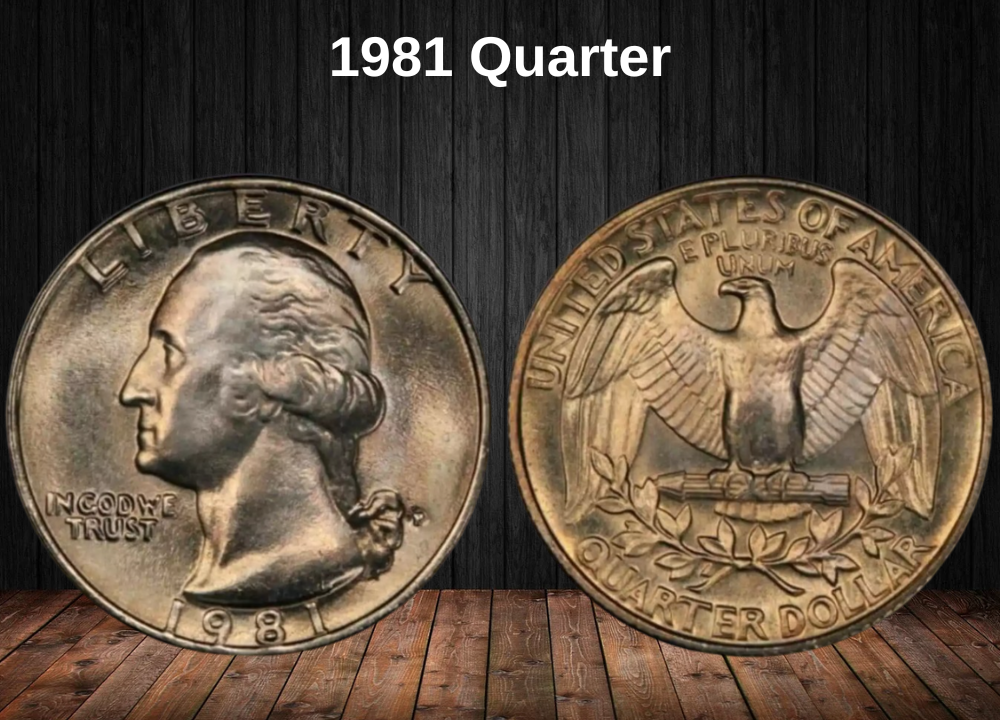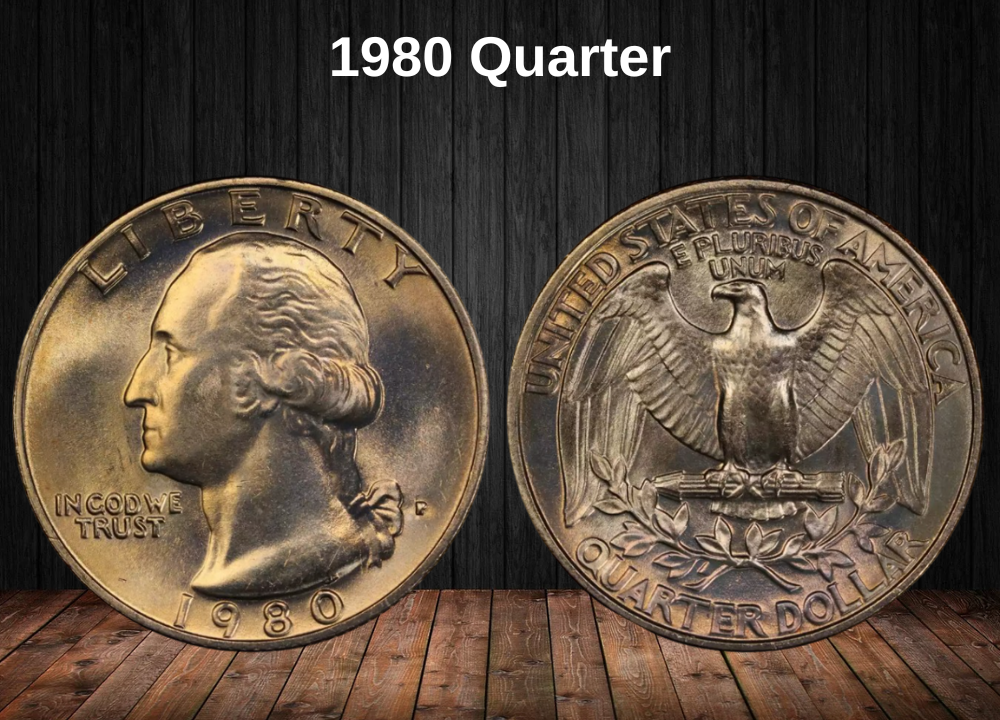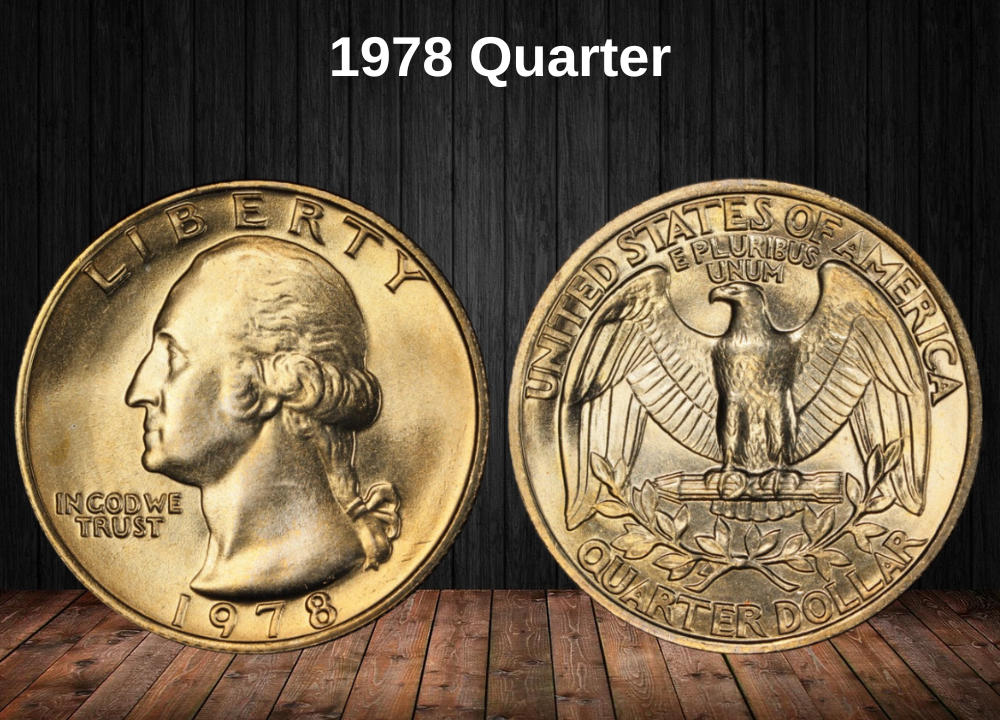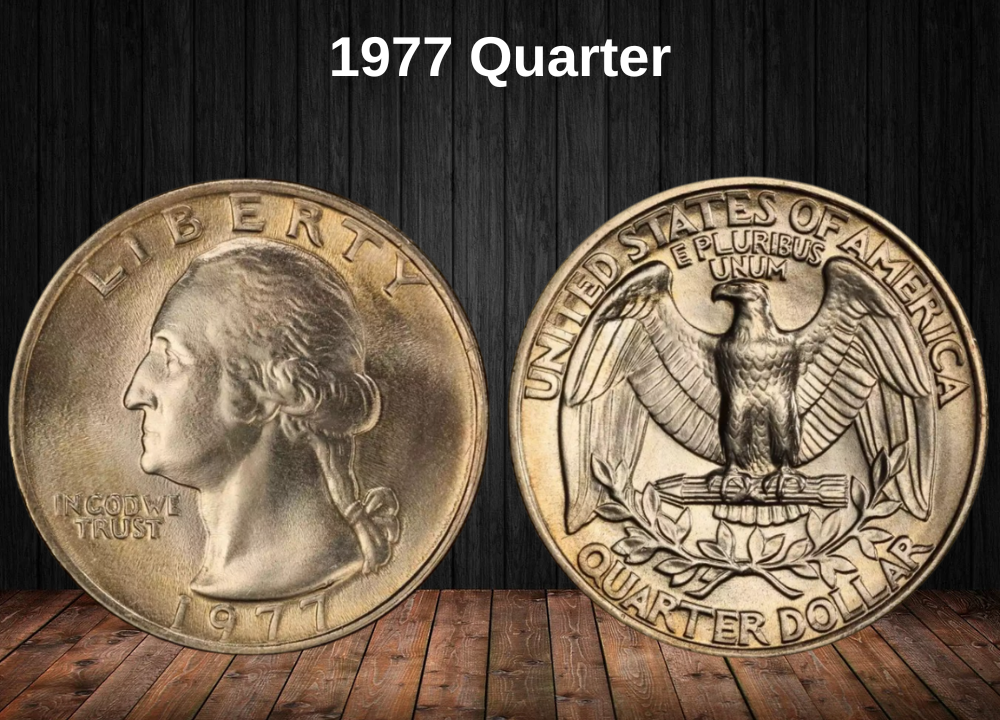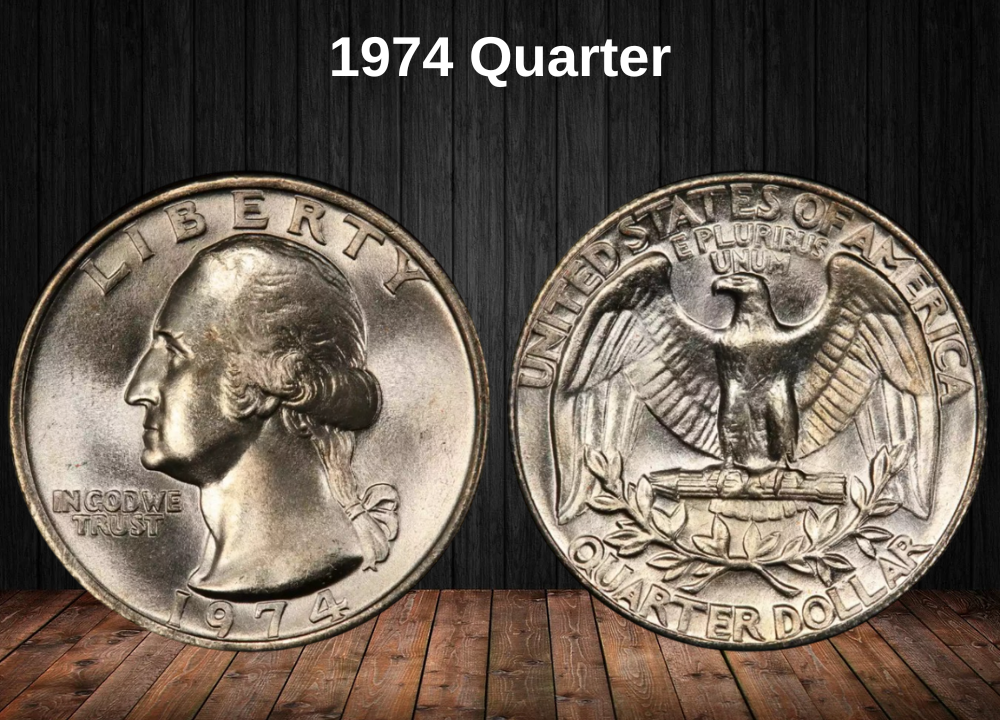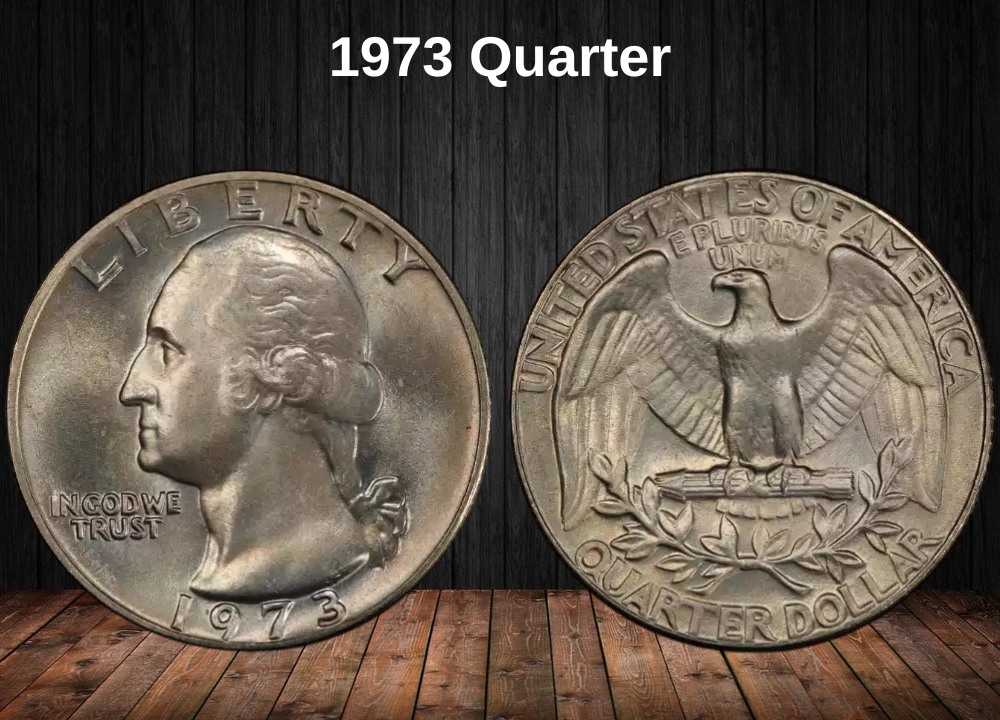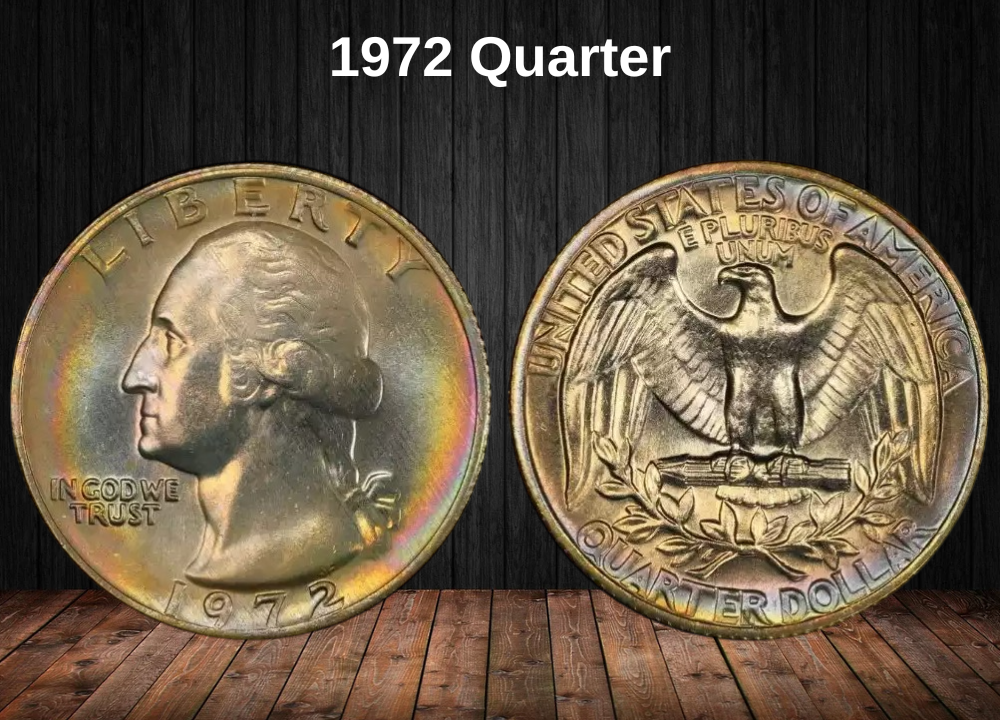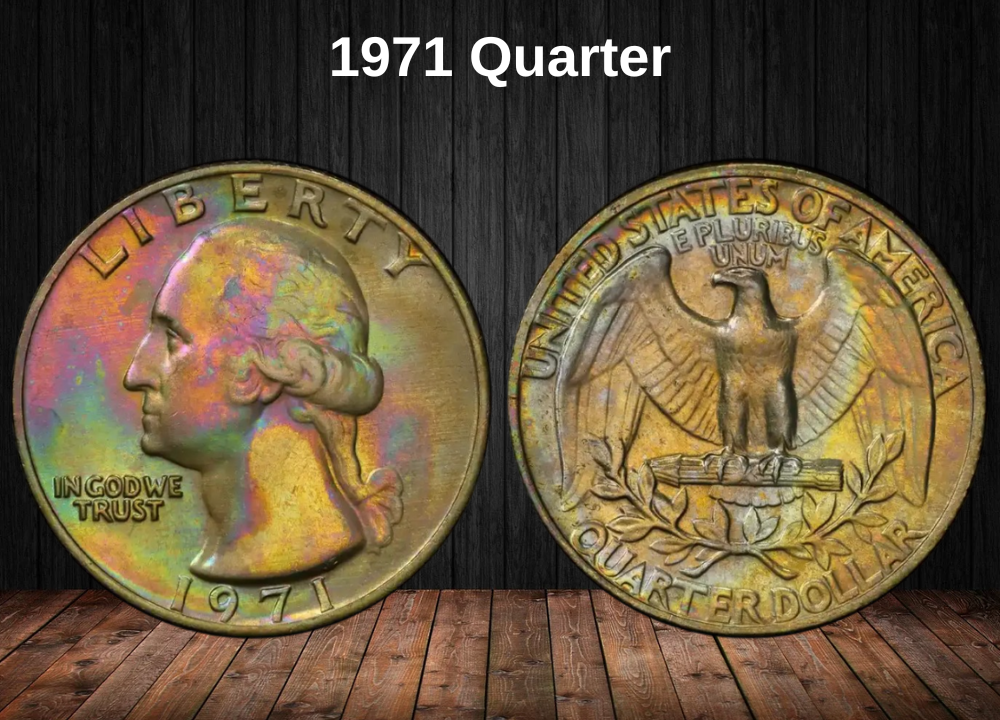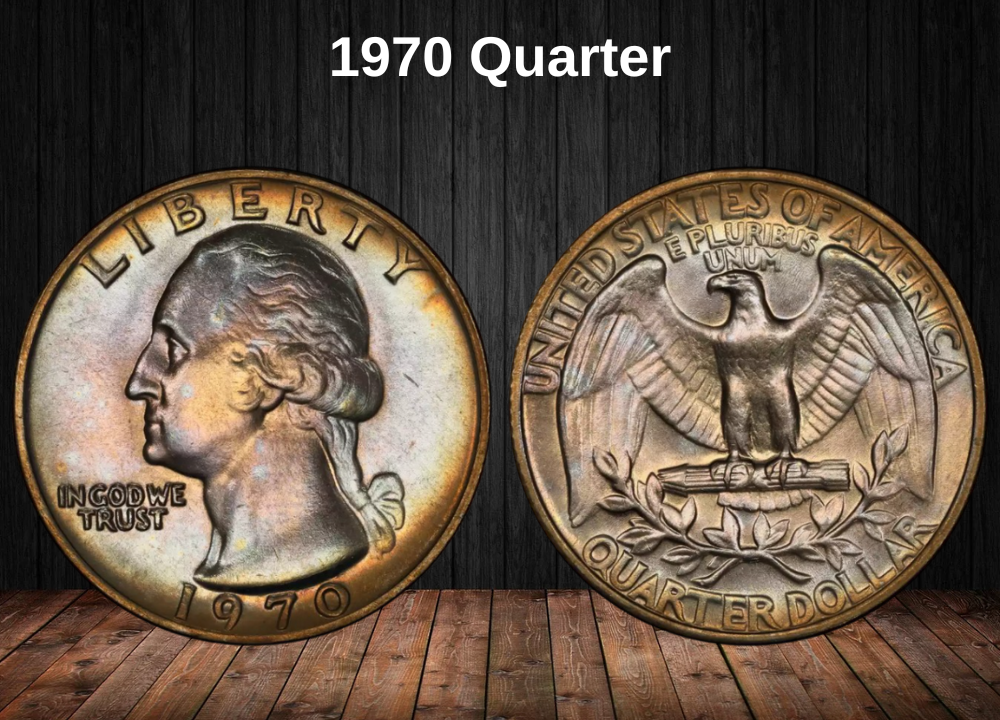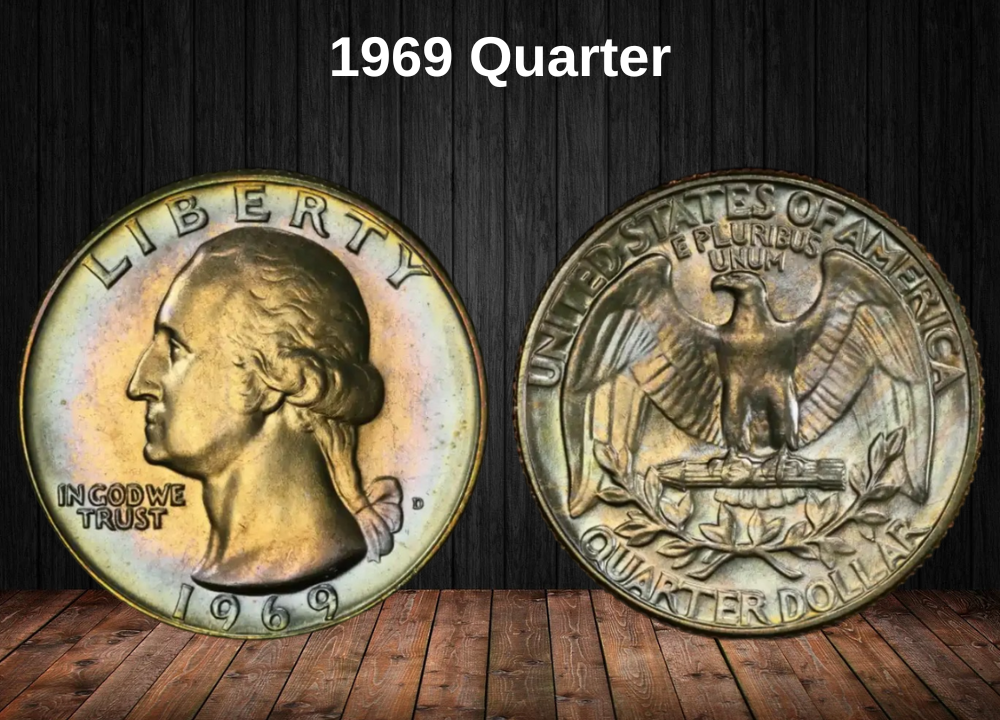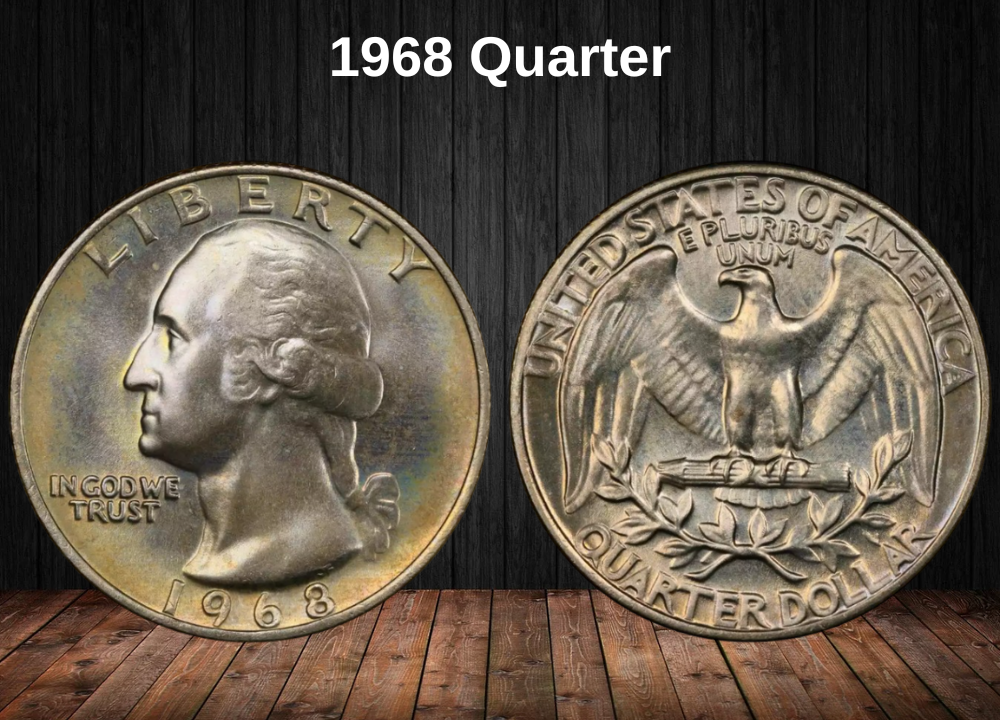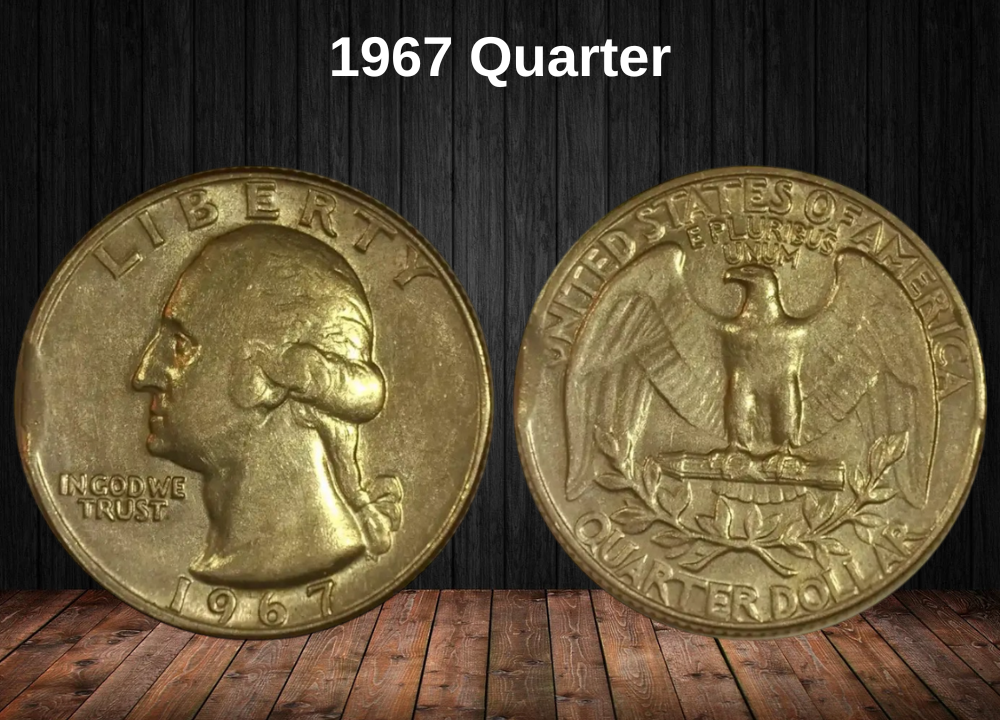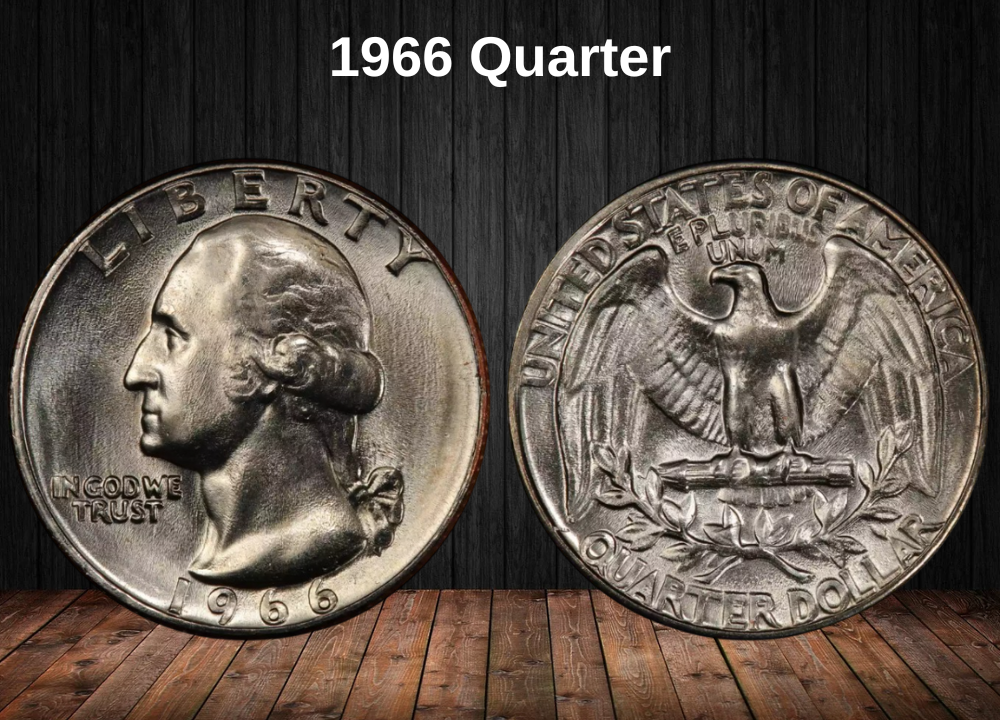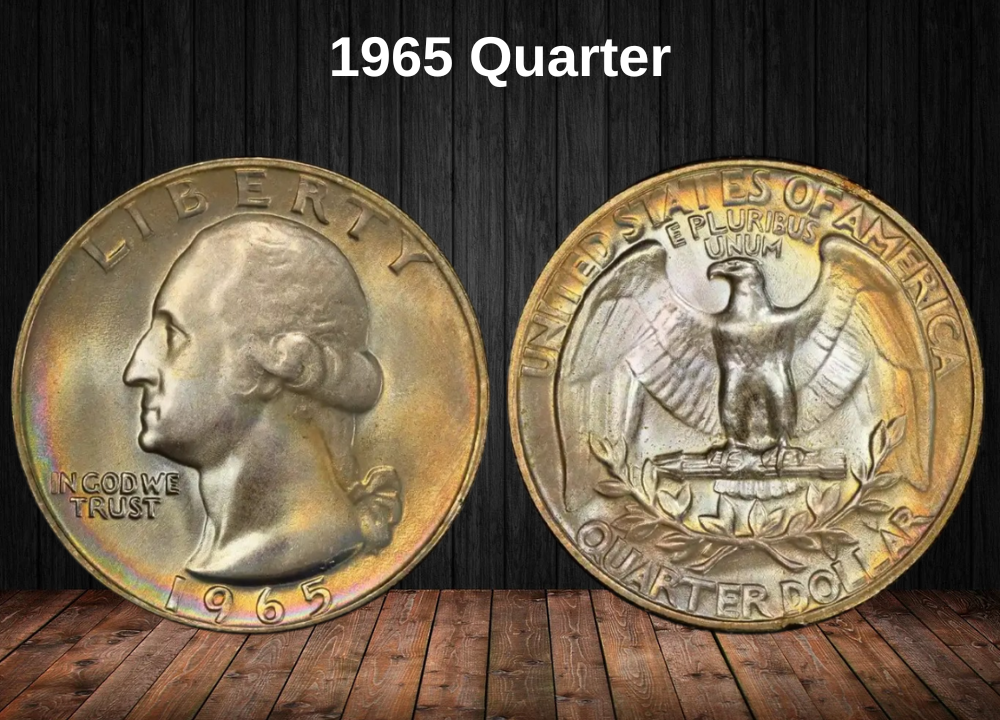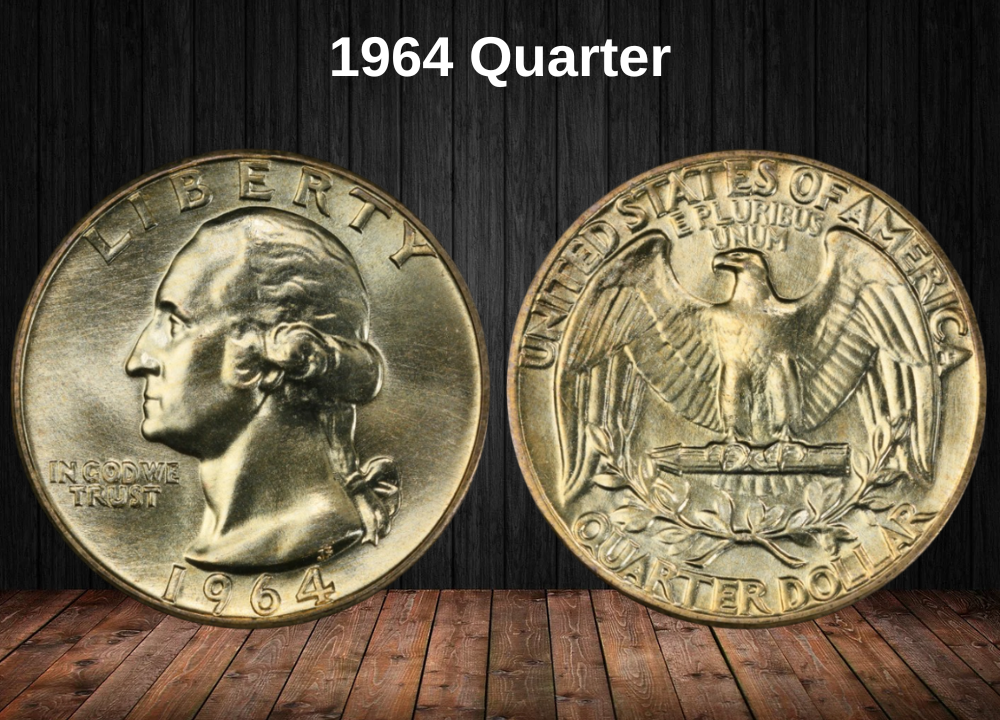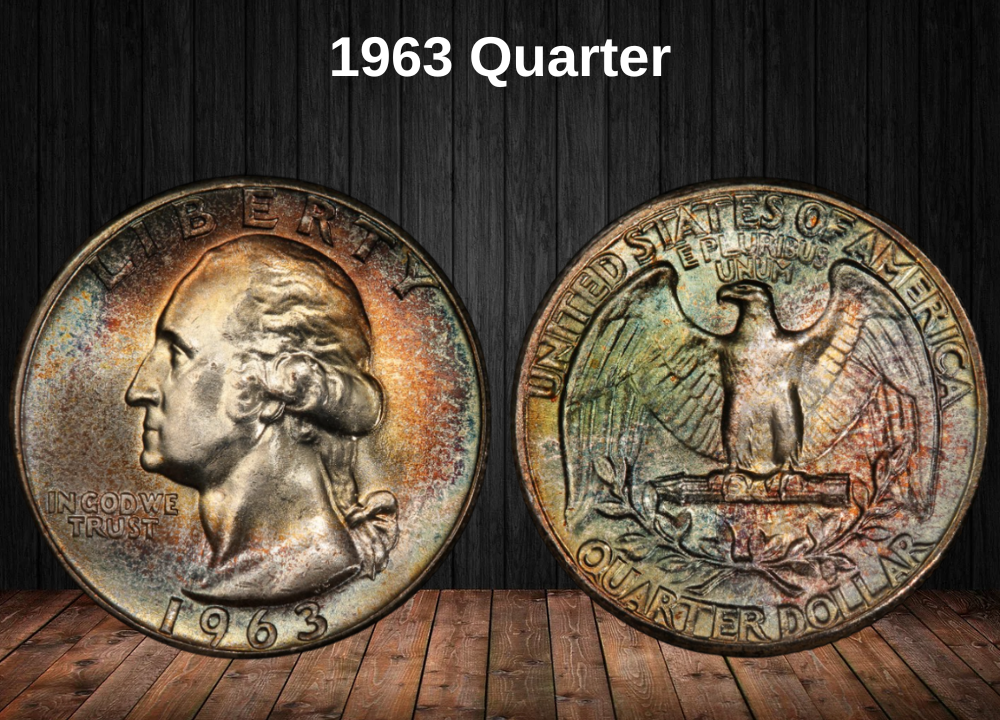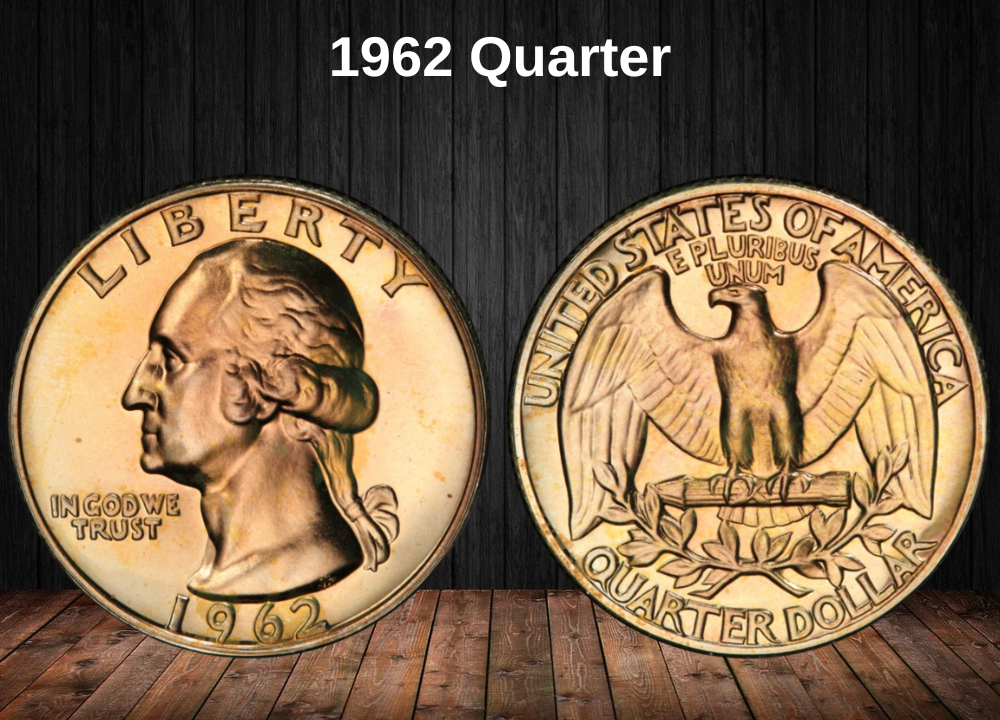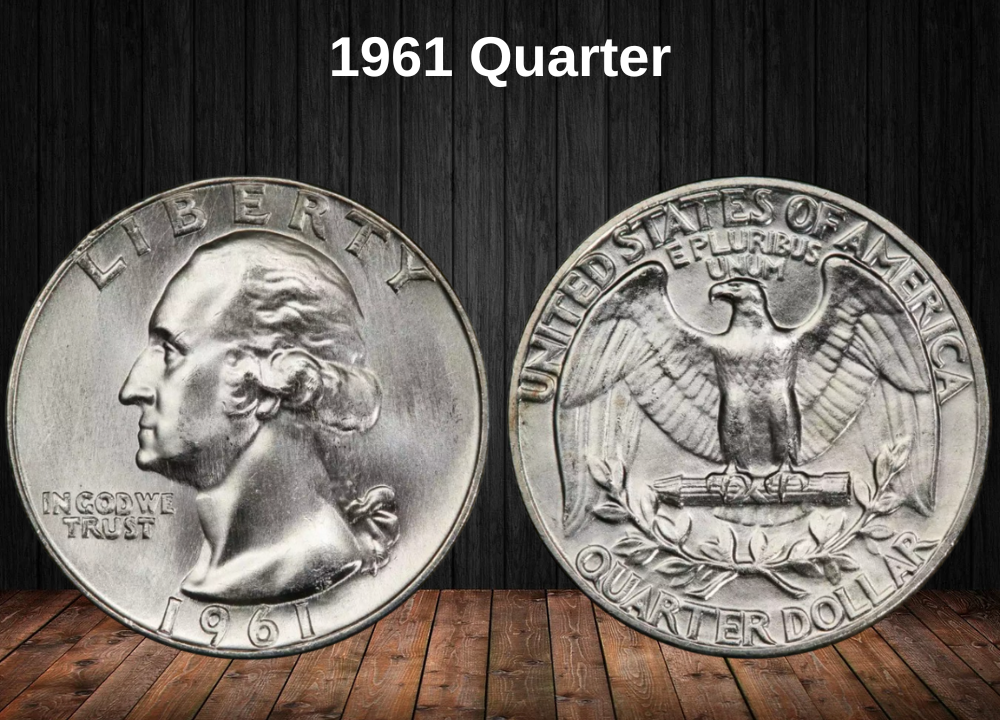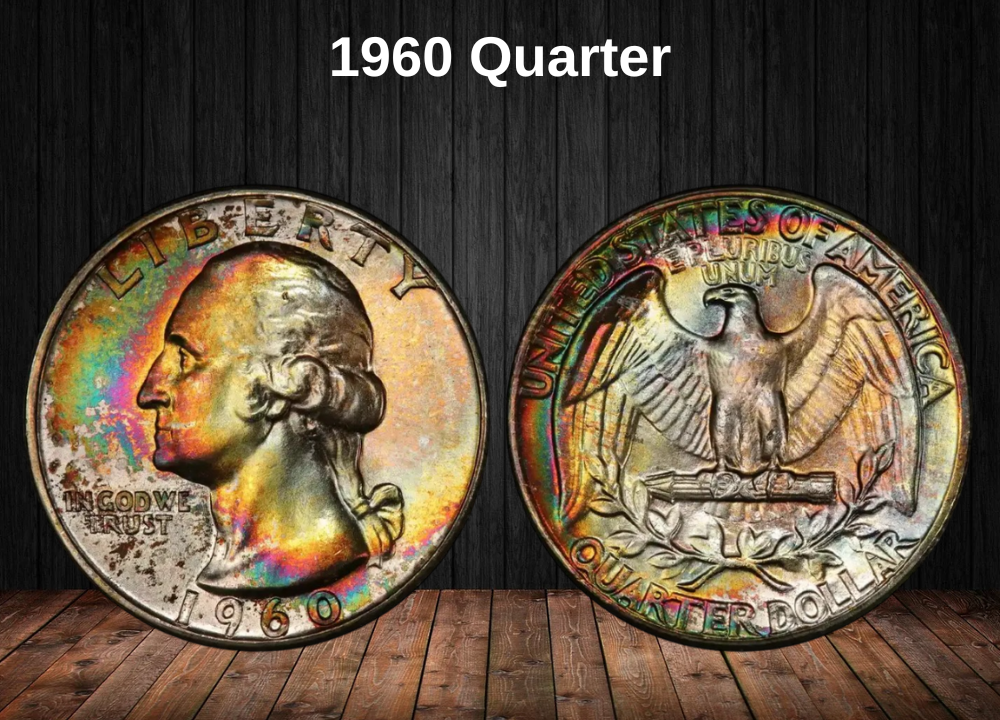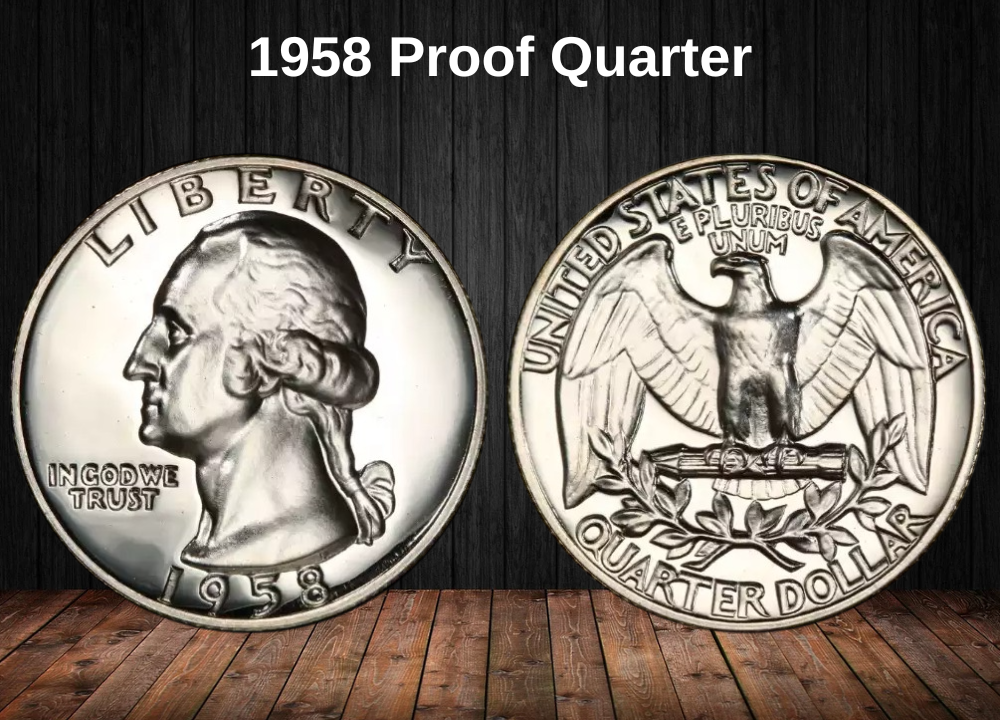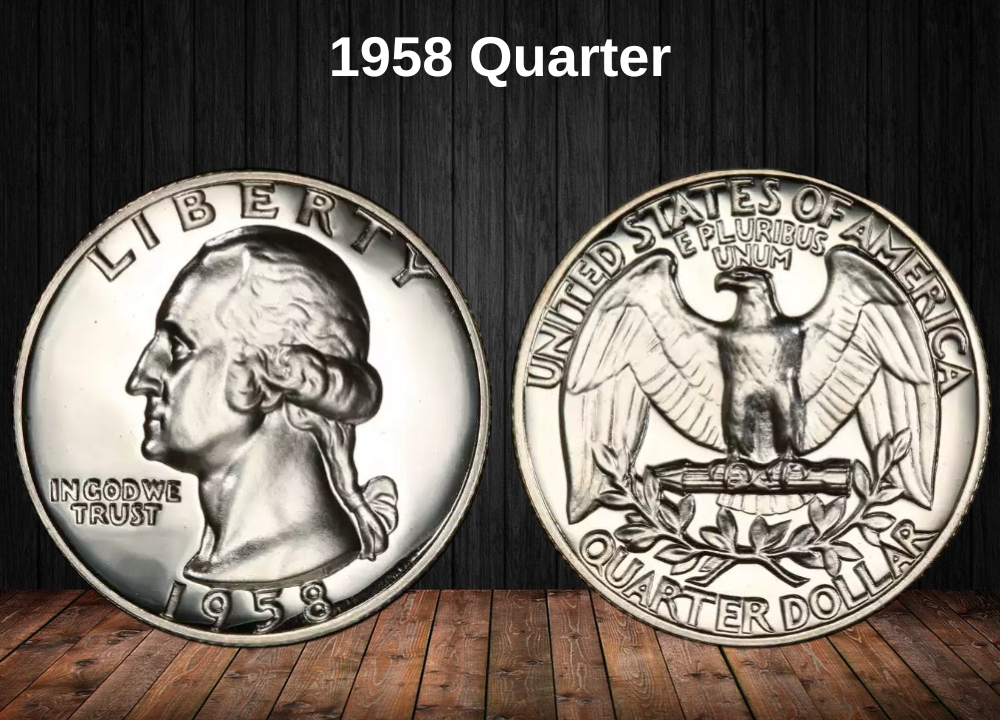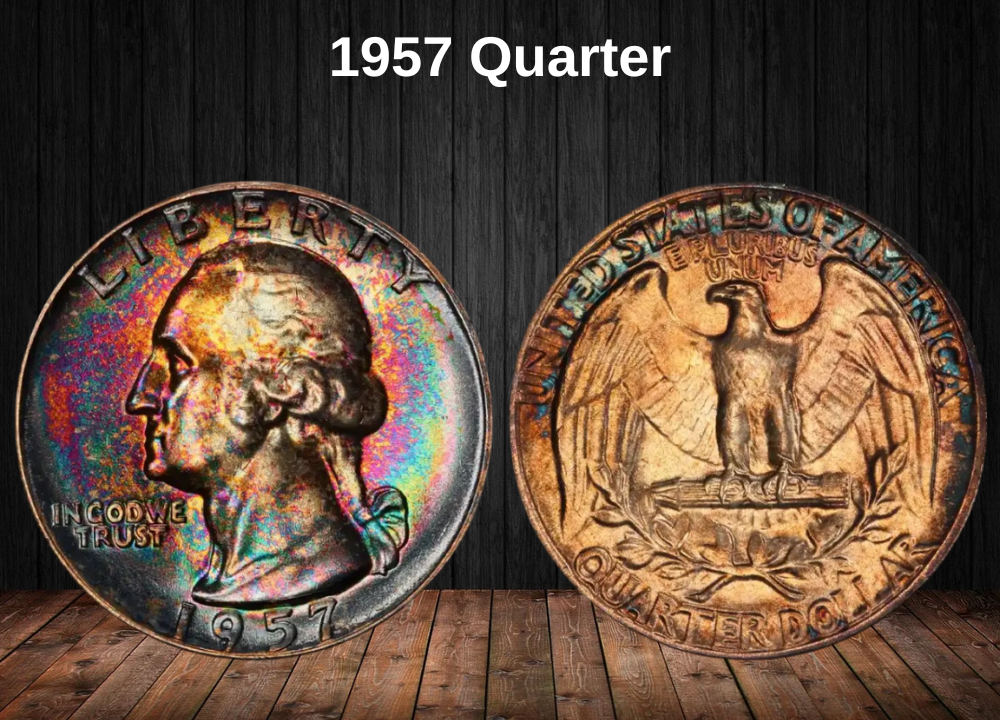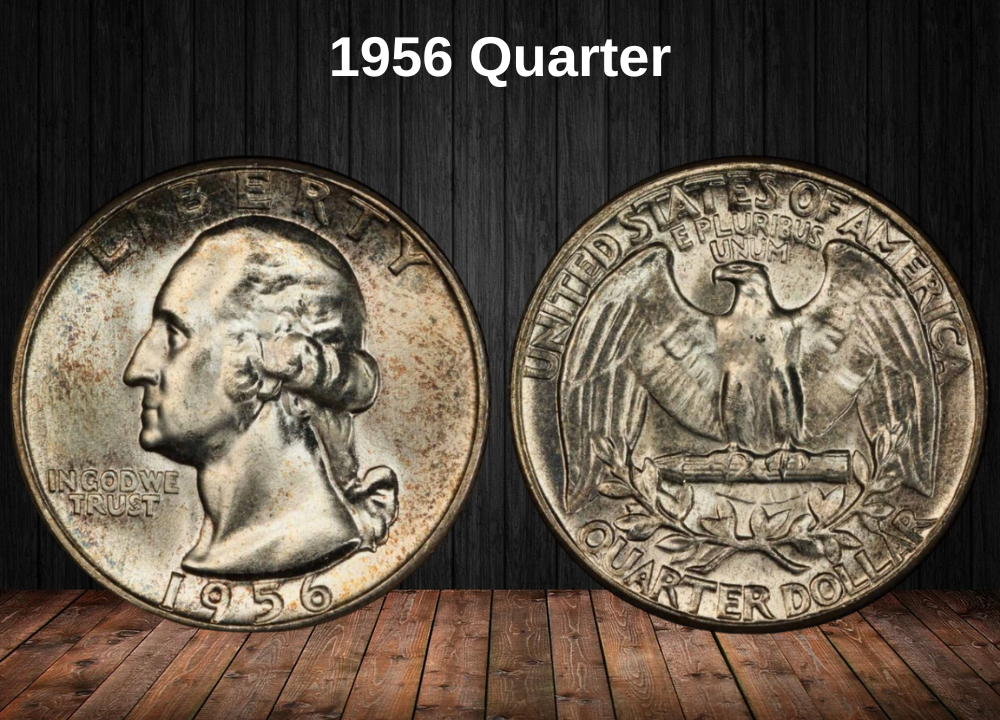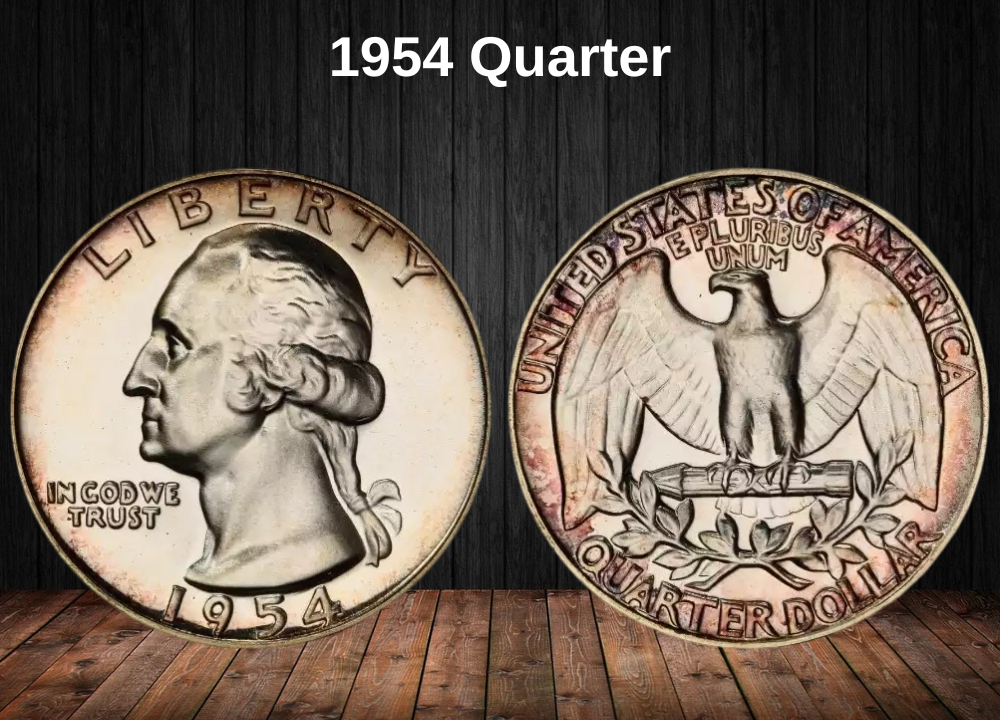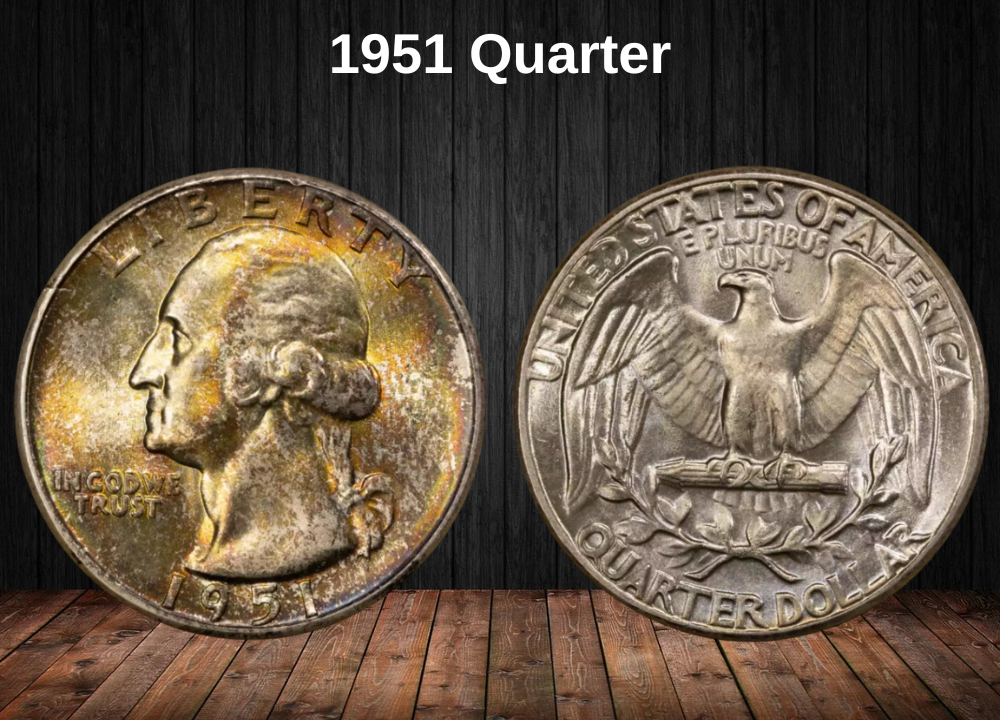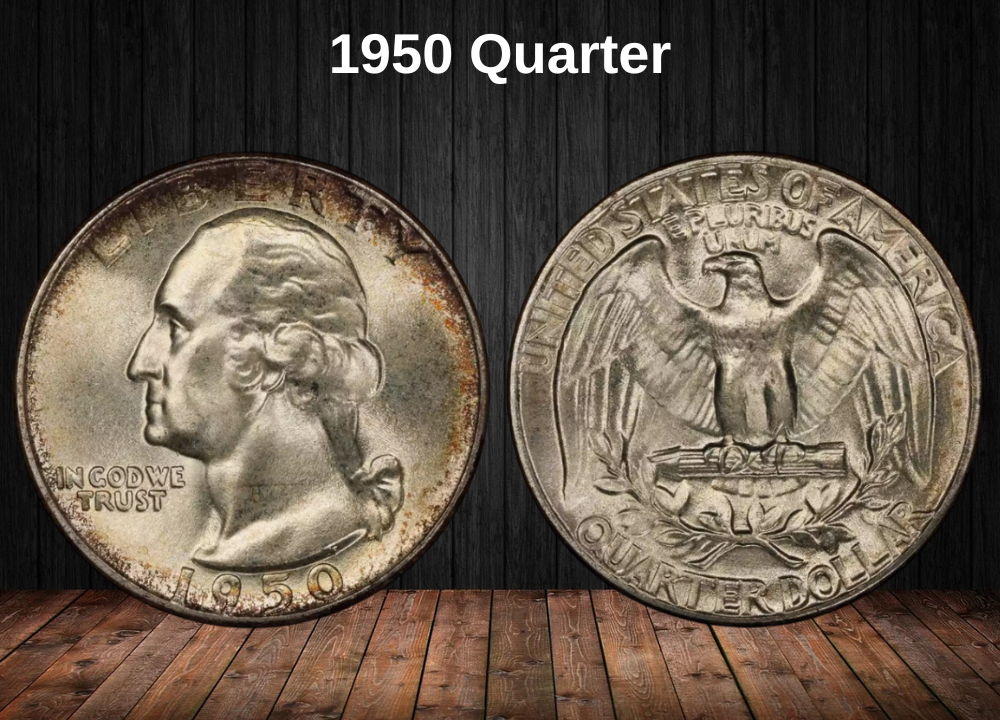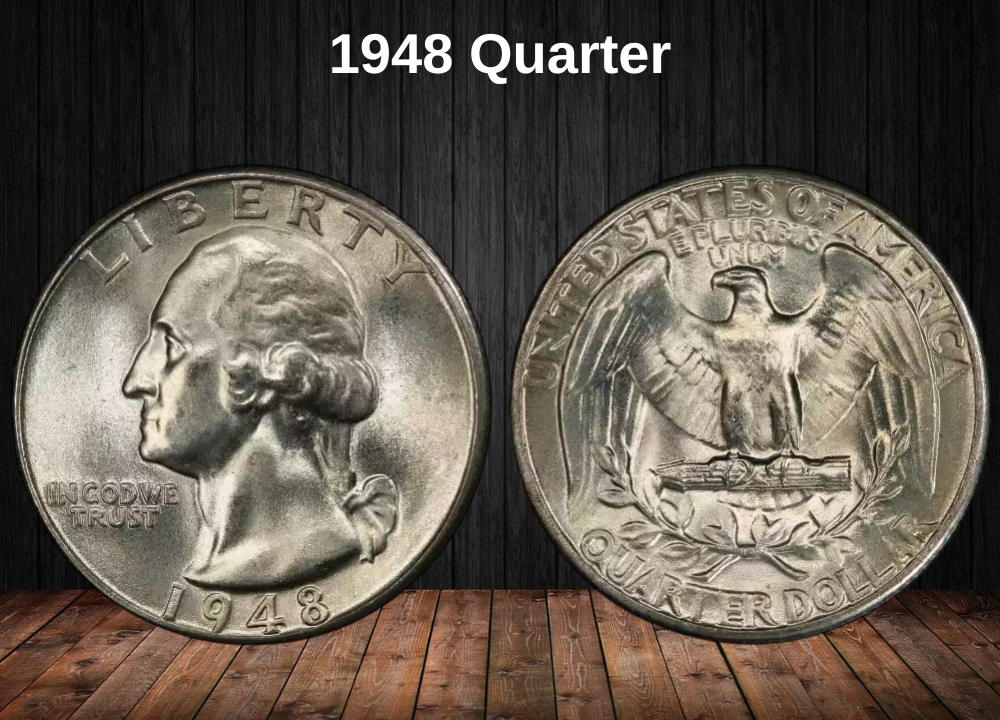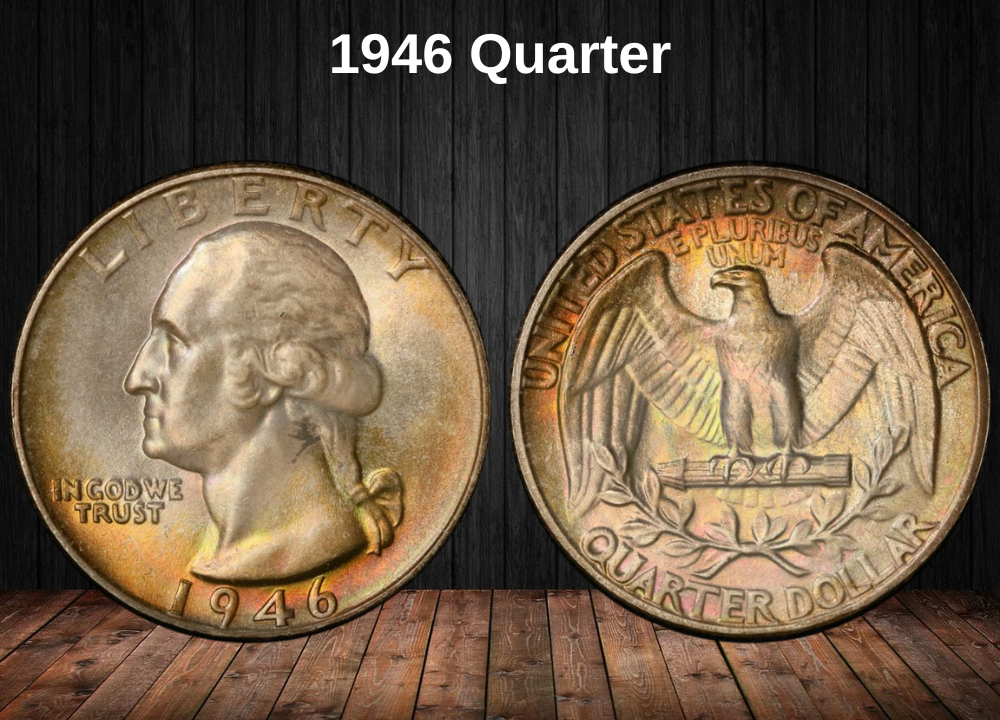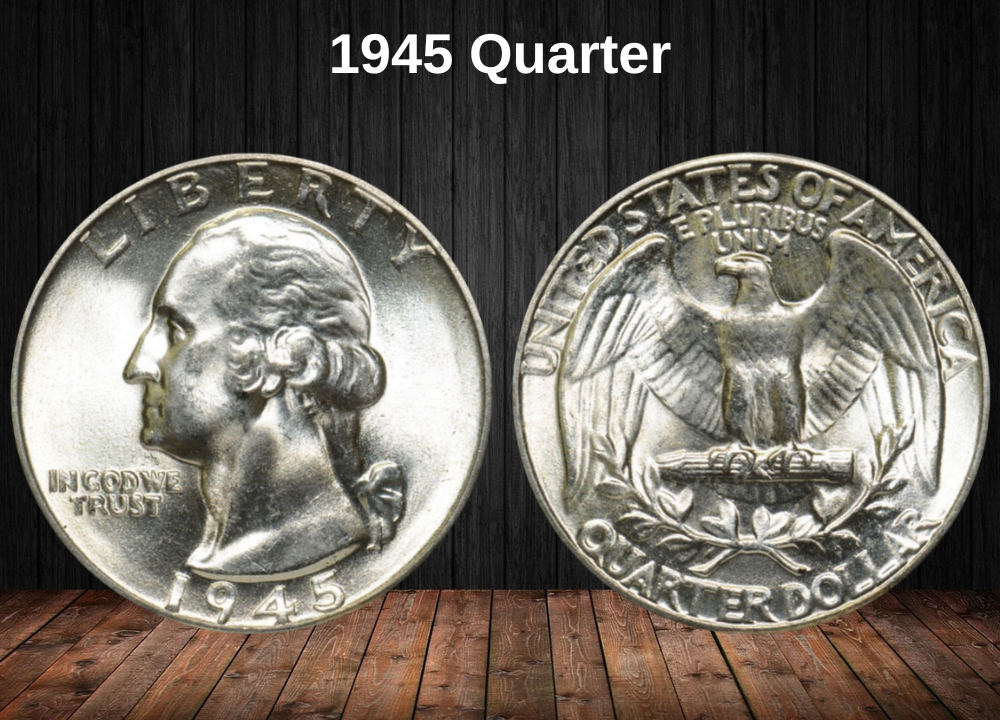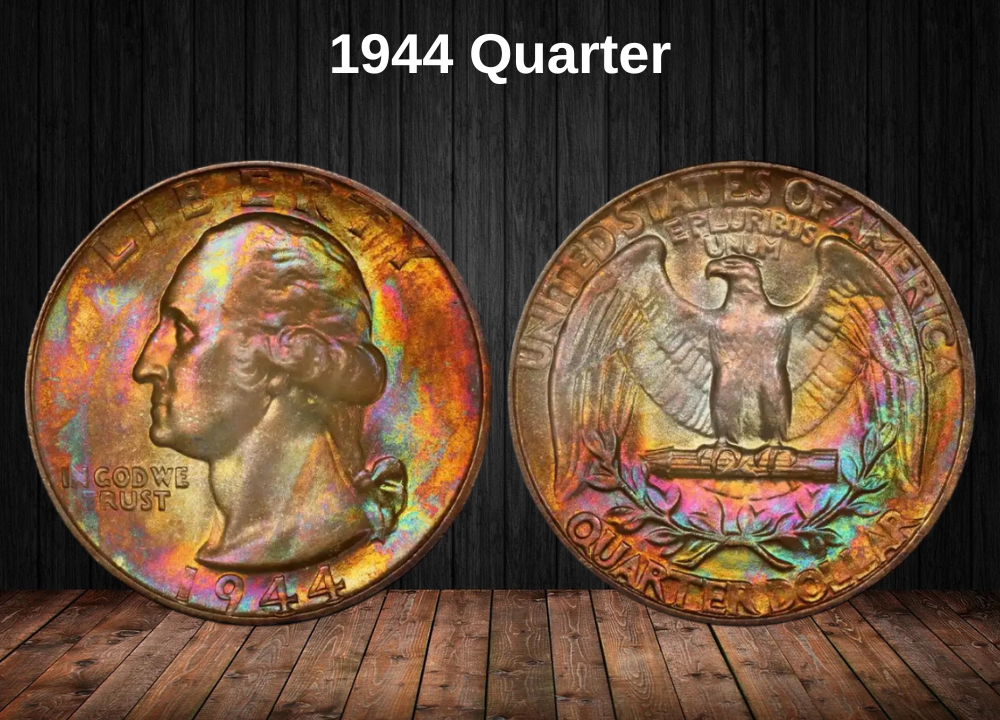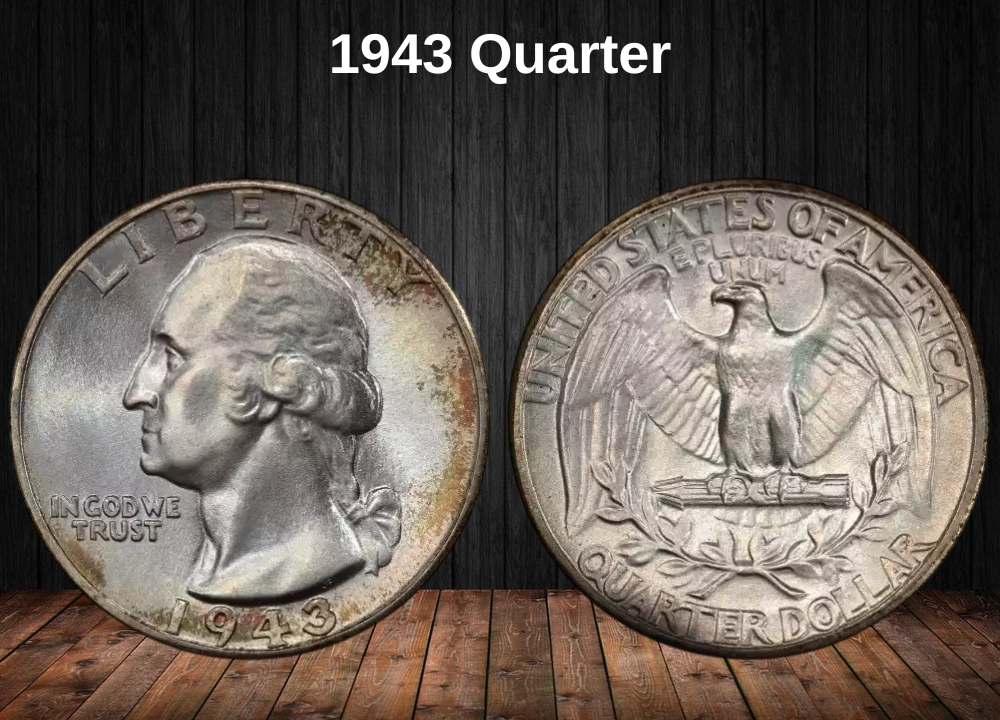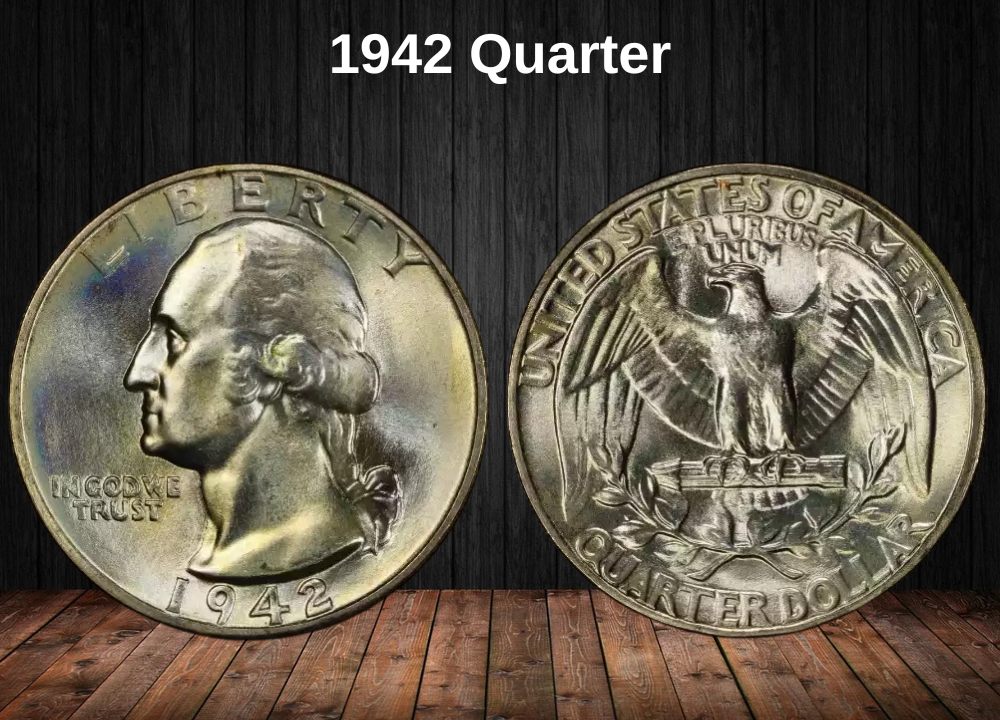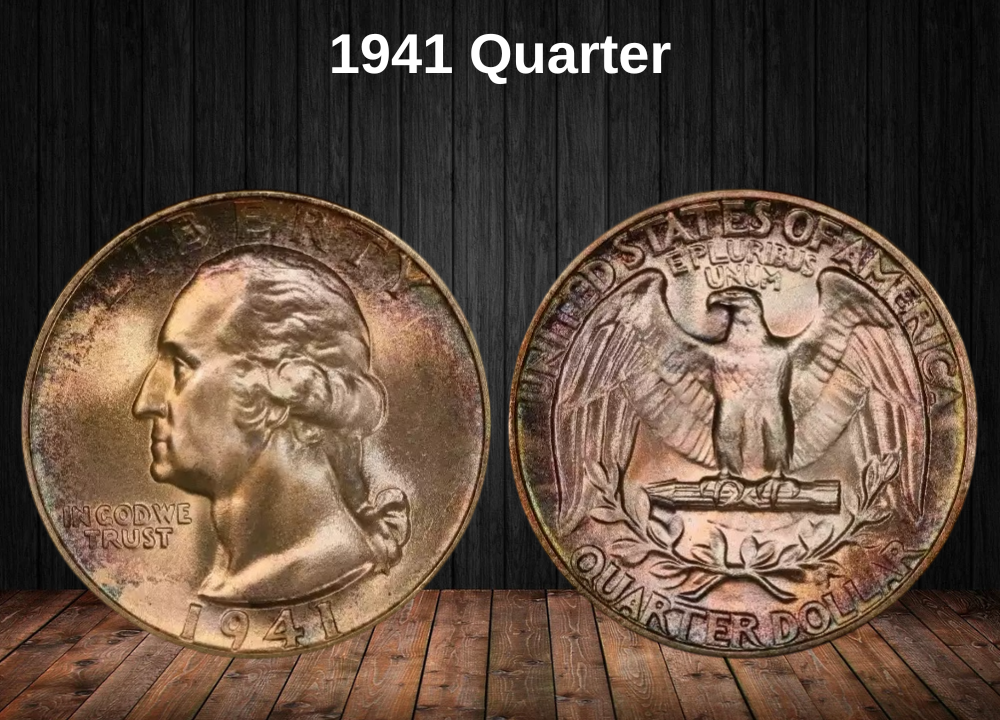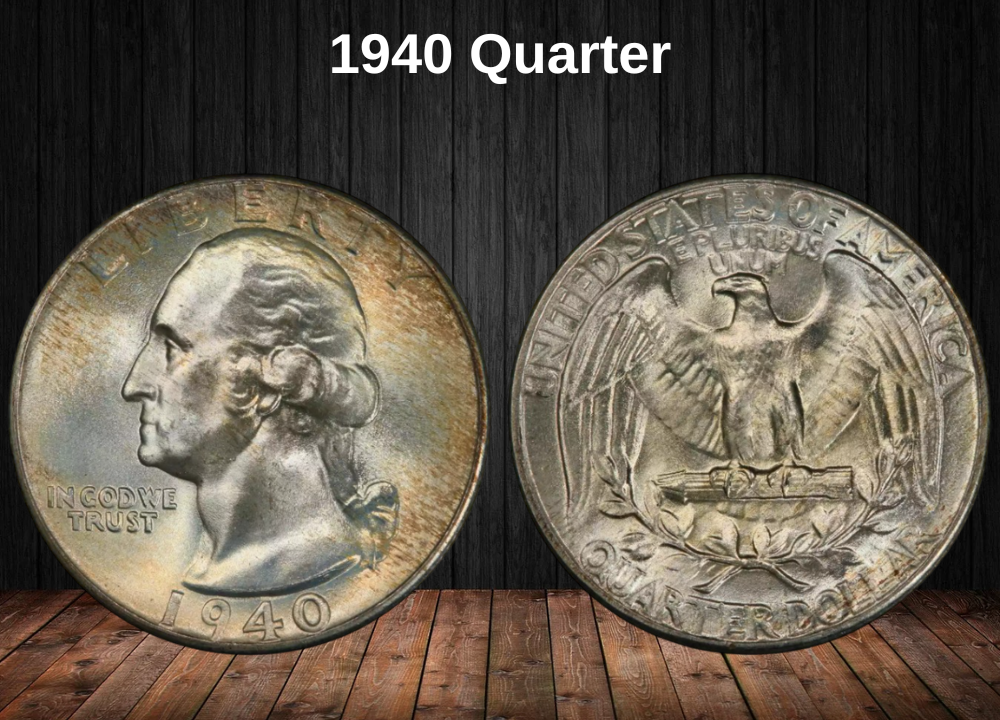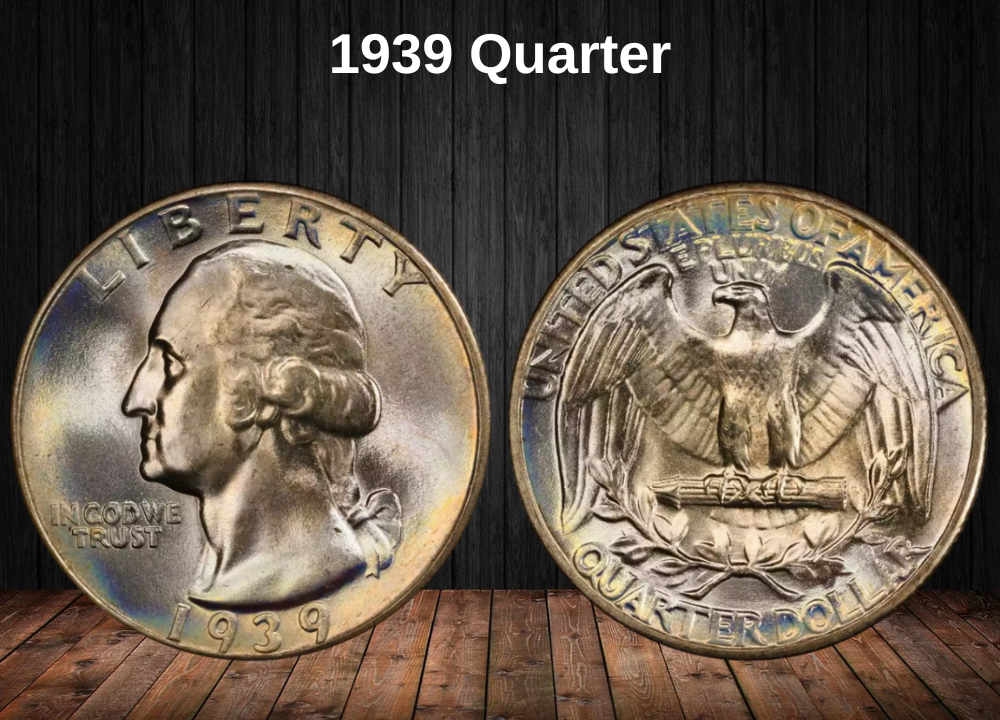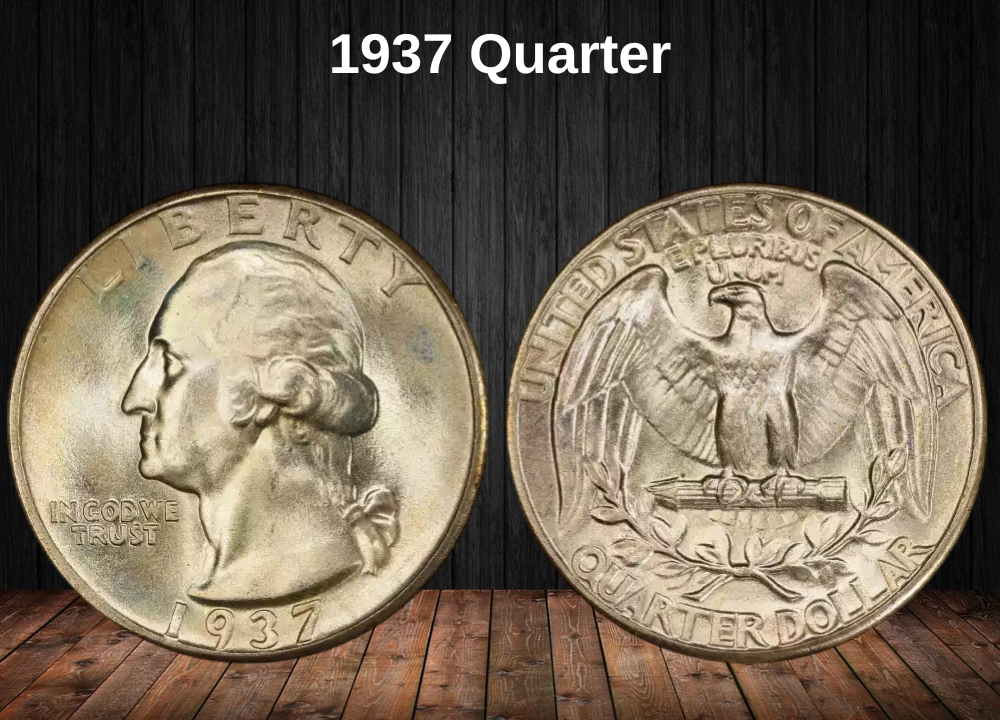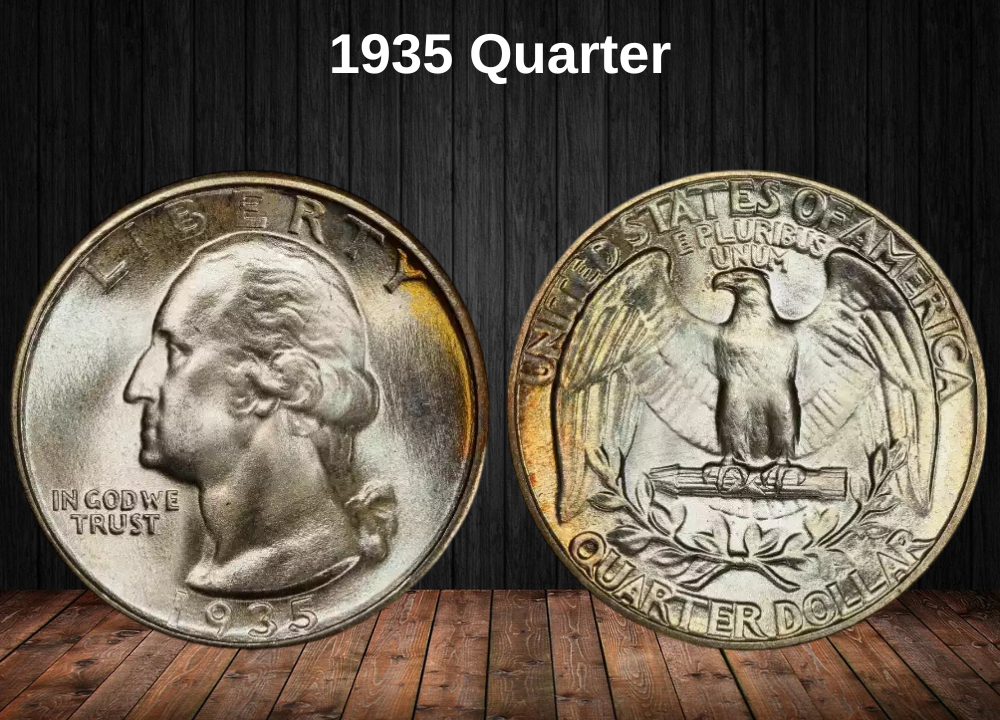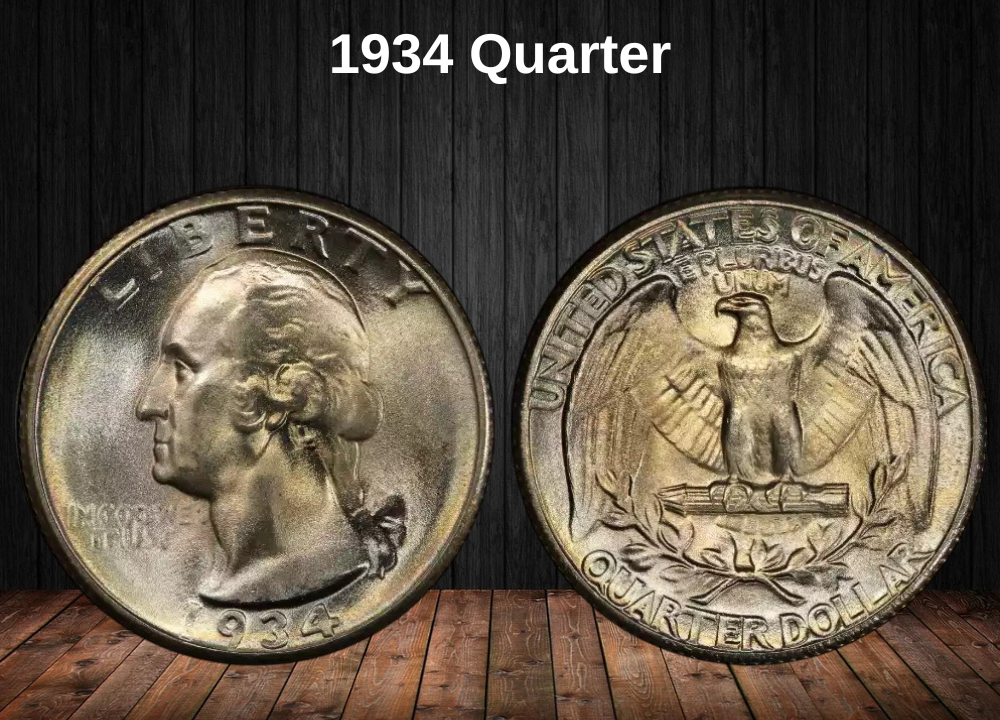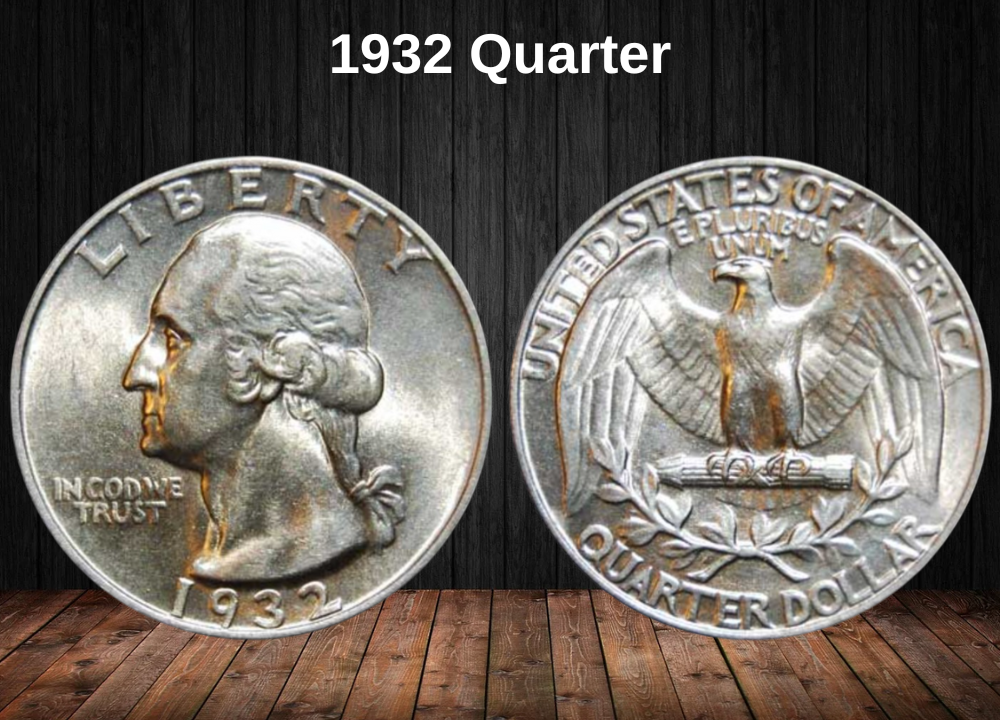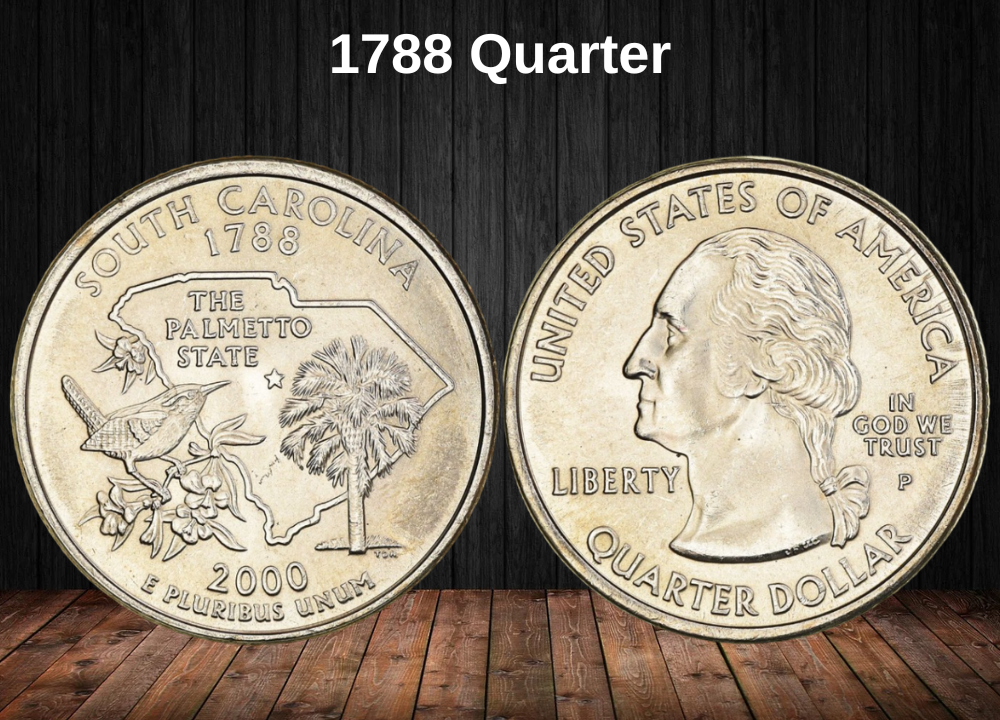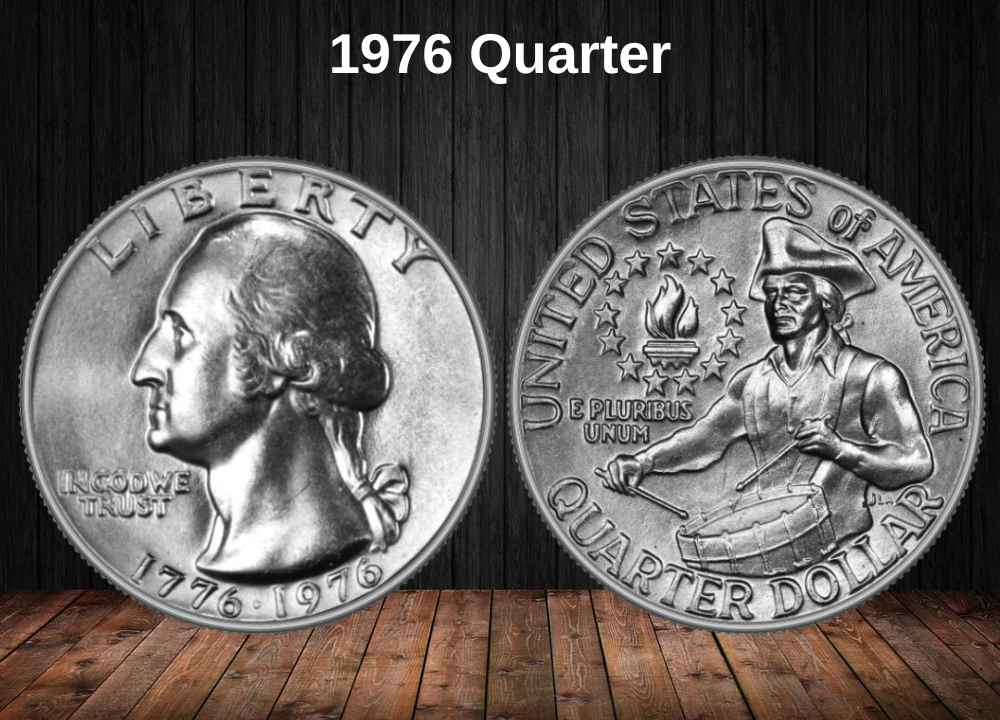The 1979 Washington Quarter represents an important transitional milestone in American coinage history. It was the last year quarters from the Philadelphia Mint carried no mint mark, closing a chapter that had lasted since the beginning of the series in 1932. Starting in 1980, Philadelphia coins began carrying the familiar “P” mint mark, ending the era of “anonymous” Philadelphia issues.
While most 1979 quarters remain common in circulation and trade for face value ($0.25), collectors pay special attention to high-grade examples and proof varieties. Philadelphia quarters can reach $8.00 in MS condition, Denver issues are more desirable at $12.33, and San Francisco produced both Type 1 and Type 2 proofs, with the scarcer Type 2 DCAM proofs valued slightly higher at $7.60.
This combination of historical importance, proof varieties, and subtle mint differences makes the 1979 quarter an attractive entry point for collectors of modern clad coinage.
1979 Quarter Value By Variety
| Type | GOOD | FINE | AU | MS | PR |
|---|---|---|---|---|---|
| 1979 No Mint Mark Quarter Value | $0.25 | $0.29 | $0.67 | $8.00 | — |
| 1979 D Quarter Value | $0.25 | $0.29 | $0.67 | $12.33 | — |
| 1979 S Type 1 DCAM Quarter Value | — | — | — | — | $7.00 |
| 1979 S Type 2 DCAM Quarter Value | — | — | — | — | $7.60 |
Top 7 Most Valuable 1979 Quarters Worth Money
| Rank | Coin / Variety | Grade | Price Realized |
|---|---|---|---|
| 1 | 1979-D Washington Quarter | MS67 | $1,440 |
| 2 | 1979 No Mint Mark Washington Quarter | MS67 | $1,200 |
| 3 | 1979-S Type 2 Proof Quarter | PR70 DCAM | $1,000 |
| 4 | 1979-S Type 1 Proof Quarter | PR70 DCAM | $800 |
| 5 | 1979-D Washington Quarter | MS66+ | $500 |
| 6 | 1979 No Mint Mark Washington Quarter | MS66+ | $400 |
| 7 | 1979-S Proof Quarter (Deep Cameo) | PR69 DCAM | $250 |
History of the 1979 Quarter
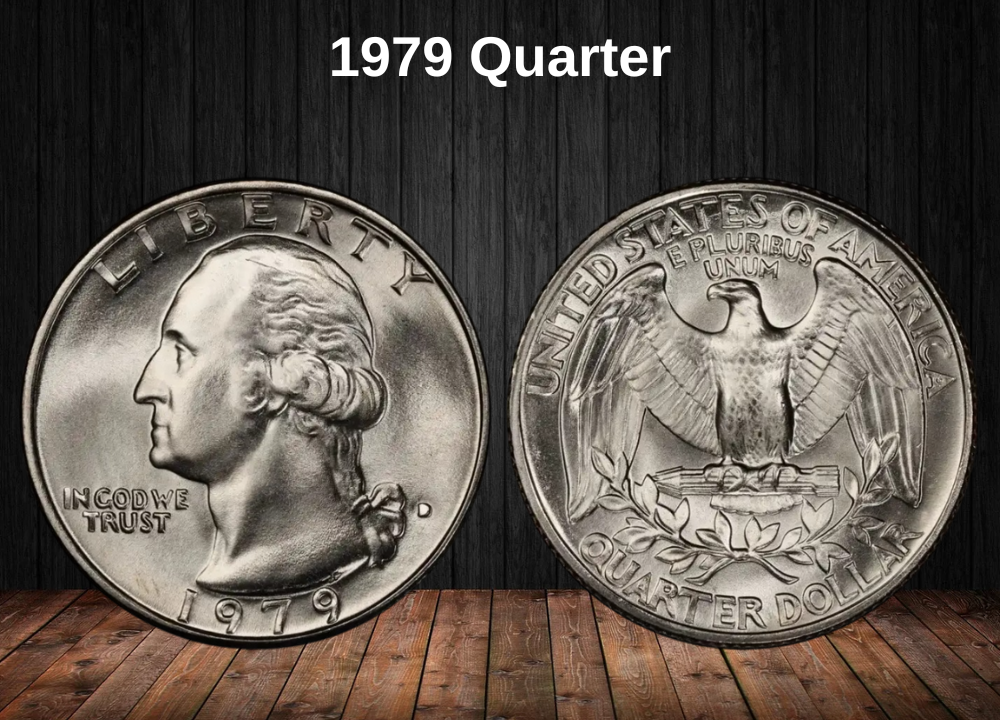
By 1979, the Washington quarter had already been circulating for nearly five decades, first introduced in 1932 to honor George Washington’s bicentennial. What makes 1979 special is that it marked the final year when Philadelphia-minted quarters carried no mint mark, closing a long-standing tradition that began with the very first Washington quarters. Starting in 1980, all Philadelphia coins would carry a “P” mint mark, making 1979 quarters the last of an era.
The coin itself was part of the copper-nickel clad generation, introduced in 1965 when silver was removed from circulating quarters due to rising bullion prices and hoarding. By 1979, the clad composition (91.67% copper and 8.33% nickel) was firmly established as the new standard for circulation coinage.
Another historical note for 1979 was the production of two different proof types at the San Francisco Mint. Collectors recognize these as Type 1 and Type 2 proofs, differentiated by the style of the mint mark “S.” The Type 1 shows a filled or “blobby” S, while the Type 2 features a clearer, sharper S. These small details make the 1979-S proofs highly collectible today.
In everyday circulation, 1979 quarters were extremely common, but the year’s importance lies in its transitional role: it closed the book on Philadelphia’s “anonymous” minting era and introduced a distinction between proof types that continues to attract collectors.
Key Features of the 1979 Quarter
The Obverse of the 1979 Quarter
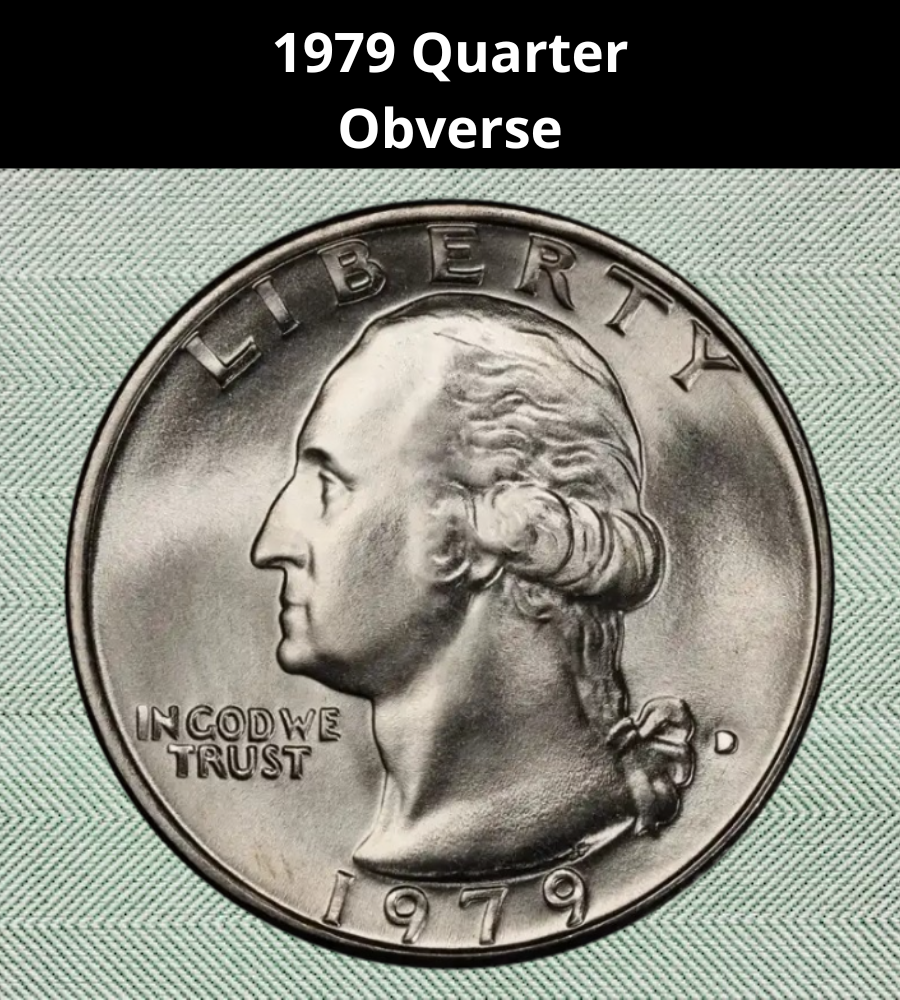
The obverse (front) of the 1979 quarter features John Flanagan’s classic portrait of George Washington in profile, facing left.
- LIBERTY arches across the top.
- IN GOD WE TRUST appears to the left of Washington’s chin.
- The year 1979 is centered at the bottom.
- Washington’s hair is tied back with a ribbon, with visible detail in the curls and bow.
Unlike later years, 1979 Philadelphia quarters do not carry a mint mark, making them historically significant as the last “anonymous” Philadelphia issue. Quarters from Denver have a small “D” mint mark to the right of the bow in Washington’s hair, and proofs from San Francisco feature an “S”.
The Reverse of the 1979 Quarter
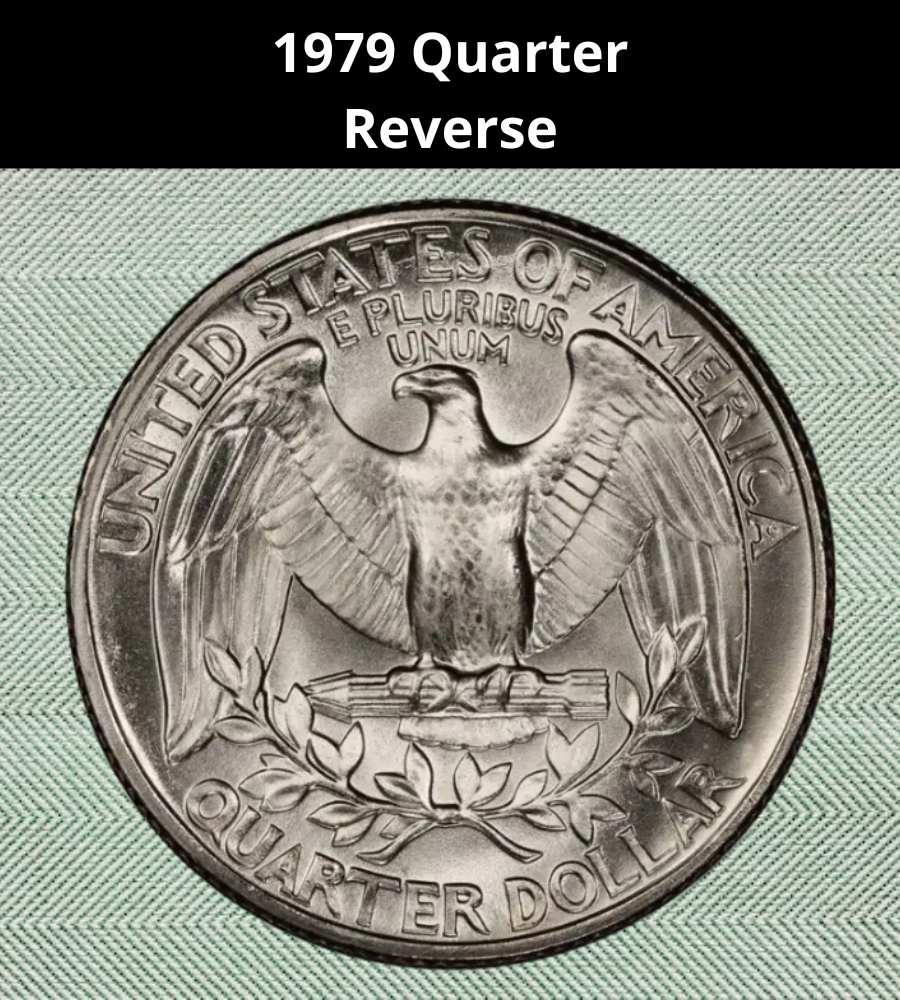
The reverse maintains the design used since 1932, also by Flanagan:
- A heraldic bald eagle with wings spread wide.
- The eagle clutches a bundle of arrows in its talons, symbolizing military strength.
- An olive branch wreath surrounds the eagle’s lower half, symbolizing peace.
- The inscriptions read:
- UNITED STATES OF AMERICA at the top.
- E PLURIBUS UNUM just above the eagle.
- QUARTER DOLLAR at the bottom.
Other Features of the 1979 Quarter
- Composition: 91.67% copper, 8.33% nickel (copper-nickel clad).
- Weight: 5.67 grams.
- Diameter: 24.3 mm.
- Edge: Reeded (119 reeds).
- Designers: John Flanagan (both obverse and reverse).
Notably, 1979 also introduced two proof types from the San Francisco Mint:
- Type 1 Proof: “S” mint mark appears filled or blob-like.
- Type 2 Proof: “S” mint mark is sharper and more defined, making it the scarcer and more desirable proof variety.
1979 Quarter Grading
Grading 1979 quarters is crucial for determining their collector value. Since most circulated examples remain at face value, higher-grade Mint State and Proof specimens are where premiums appear. Key details to examine include:
- Obverse (front): Look for sharp detail in Washington’s hair curls and cheek with minimal wear.
- Reverse (back): Inspect the eagle’s breast feathers and arrow tips for clarity.
- Strike quality: Weak strikes are common, especially on Denver coins, so sharp examples command higher prices.
- Proofs: Cameo (CAM) and Deep Cameo (DCAM) contrasts greatly affect value, with Type 2 “S” mint marks being scarcer.
1979 Quarter Grading/Value Chart
| Grade | Description | Average Value Range |
|---|---|---|
| G-4 (Good) | Heavy wear, major details flat, rims worn | $0.25 |
| F-12 (Fine) | Moderate wear, LIBERTY and eagle visible but flat | $0.29 |
| AU-50 (About Uncirculated) | Light wear on high points, nearly full details | $0.67 |
| MS-60 (Mint State) | Uncirculated but with contact marks and dull luster | $2 – $4 |
| MS-63 (Choice Uncirculated) | Strong luster, minor marks, well-struck | $8 – $15 |
| MS-65 (Gem Uncirculated) | Bright luster, sharp strike, few imperfections | $40 – $80 |
| MS-67 (Superb Gem) | Exceptional strike, nearly flawless | $300 – $500+ (Denver issues often higher) |
| PR-65 (Proof) | Mirror fields, minor marks | $5 – $7 |
| PR-67 CAM | Strong cameo contrast, crisp details | $15 – $25 |
| PR-69 DCAM (Type 2) | Deep cameo, ultra-contrast fields, nearly perfect | $60 – $120 |
1979 Quarter Value Guides
1979 No Mint Mark Quarter Value
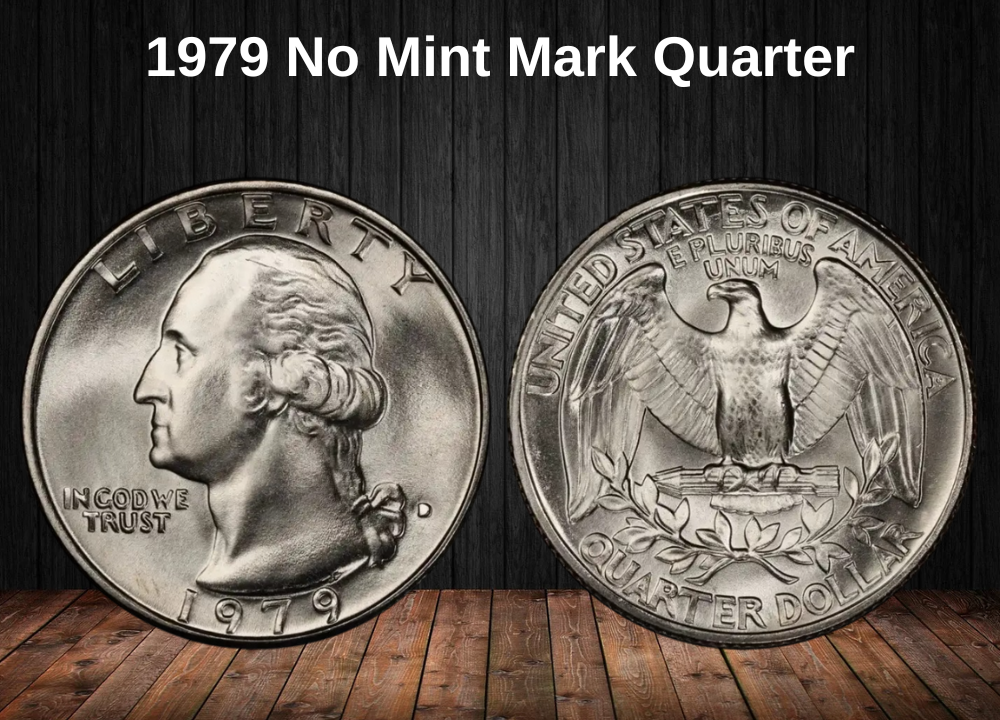
The 1979 Philadelphia quarter (struck without a mint mark) represents the final year before the U.S. Mint began adding the “P” mint mark in 1980. This makes it historically significant, even if most examples remain common in circulation today.
Philadelphia produced 515,708,000 quarters in 1979, meaning worn pieces are readily available at face value. However, high-grade Mint State examples are scarce due to weak strikes and heavy bag marks from mass production. Collectors place strong premiums on specimens graded MS-65 and higher, with superb MS-67 coins being especially rare.
Key identifiers include:
- No mint mark on the obverse (to the right of Washington’s hair ribbon).
- Copper-nickel clad composition, weighing 5.67 grams.
- Standard John Flanagan portrait and heraldic eagle reverse.
1979 No Mint Mark Quarter Value Chart
| Grade | Value Range |
|---|---|
| Good (G-4) | $0.25 |
| Fine (F-12) | $0.29 |
| About Uncirculated (AU-50) | $0.67 |
| Mint State (MS-60) | $2 – $4 |
| Mint State (MS-63) | $6 – $10 |
| Mint State (MS-65) | $25 – $45 |
| Mint State (MS-67) | $200 – $350+ |
1979-D Quarter Value
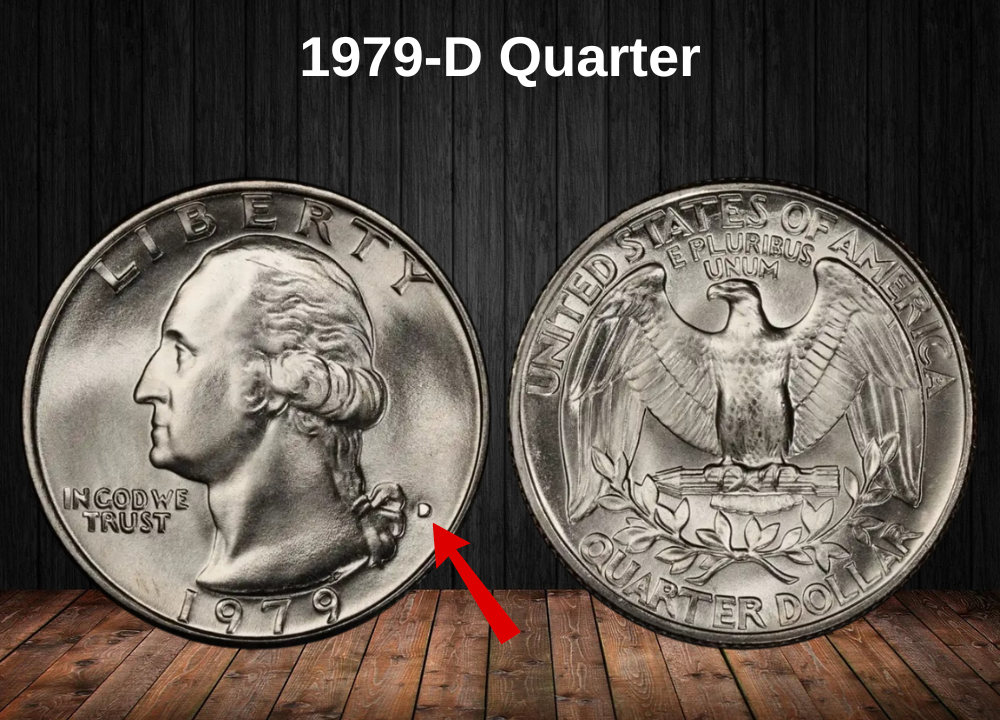
The 1979-D Washington quarter, struck at the Denver Mint, had an enormous mintage of 489,789,780 coins, making it one of the most common clad quarters of the late 1970s. Like its Philadelphia counterpart, most circulated examples trade only for their face value.
However, Denver issues are generally sharper in strike than Philadelphia coins, and collectors often seek out high-grade Mint State specimens. The true value lies in premium examples graded MS-65 and above, where clean surfaces and full luster set them apart from typical circulation strikes.
The 1979-D quarter remains affordable in most grades, but gem-quality examples and conditional rarities can bring substantial premiums.
1979-D Quarter Value Chart
| Grade | Value Range |
|---|---|
| Good (G-4) | $0.25 |
| Fine (F-12) | $0.29 |
| About Uncirculated (AU-50) | $0.67 |
| Mint State (MS-60) | $3 – $5 |
| Mint State (MS-63) | $8 – $15 |
| Mint State (MS-65) | $35 – $60 |
| Mint State (MS-67) | $250 – $450+ |
1979-S Type 1 DCAM Quarter Value
The 1979-S Type 1 Proof quarter was struck at the San Francisco Mint as part of the annual proof set program. Type 1 proofs are identified by their “blobby” S mint mark, which appears filled or less sharply defined than the improved Type 2 style introduced later in the year.
These coins were made with highly polished dies, producing the Deep Cameo (DCAM) effect—frosted design elements contrasting against mirror-like fields. As the first proof type of 1979, Type 1s are slightly more common than Type 2s, but collectors still prize them for their strong visual appeal and place in the transitional mint mark history of the late 1970s.
Because proof coins were never released into circulation, all surviving examples remain in excellent condition, with their value determined by cameo contrast and numerical grade.
1979-S Type 1 DCAM Quarter Value Chart
| Grade | Value Range |
|---|---|
| PR-64 DCAM | $4 – $5 |
| PR-65 DCAM | $5 – $6 |
| PR-66 DCAM | $6 – $7 |
| PR-67 DCAM | $7 – $8 |
| PR-68 DCAM | $8 – $9 |
| PR-69 DCAM | $10 – $12 |
| PR-70 DCAM | $25 – $40+ |
1979-S Type 2 DCAM Quarter Value
The 1979-S Type 2 Proof quarter represents the improved version of the San Francisco Mint’s proof production that year. Unlike the “blobby” and less defined mint mark seen on Type 1 coins, the Type 2 features a clear, sharply defined “S” mint mark, making it much easier to identify and far more desirable to collectors.
Struck with polished dies and under controlled proof conditions, these coins exhibit the coveted Deep Cameo (DCAM) finish, with frosted design devices set against deeply mirrored fields. The improved quality of the Type 2 mint mark also makes these coins more visually appealing and collectible, especially in higher grades.
Although more scarce than Type 1 proofs, the premium largely comes from collector preference for the cleaner, more attractive mint mark style, as both types were issued in similar proof set quantities.
1979-S Type 2 DCAM Quarter Value Chart
| Grade | Value Range |
|---|---|
| PR-64 DCAM | $5 – $6 |
| PR-65 DCAM | $6 – $7 |
| PR-66 DCAM | $7 – $8 |
| PR-67 DCAM | $8 – $9 |
| PR-68 DCAM | $9 – $10 |
| PR-69 DCAM | $12 – $15 |
| PR-70 DCAM | $50 – $100+ |
1979-S Type 2 FS-501 DCAM Quarter Value
The 1979-S Type 2 FS-501 is a highly collectible repunched mint mark (RPM) variety found on some Deep Cameo proof quarters. This error occurred when the “S” mint mark was punched more than once into the die, creating subtle doubling or shadow effects visible under magnification.
What makes the FS-501 particularly desirable is its combination of proof quality, Type 2 clear “S” mint mark, and Deep Cameo contrast. These three attributes—error variety, superior mint mark style, and exceptional strike finish—place this coin at the top tier of modern proof Washington quarter collecting.
For collectors, authenticated FS-501 examples are both rare and valuable, since only a small fraction of proof dies displayed this repunching error. In PR-69 DCAM, this coin becomes especially prized due to its nearly flawless surfaces paired with the dramatic minting anomaly.
1979-S Type 2 FS-501 DCAM Quarter Value Chart
| Grade | Value Range |
|---|---|
| PR-64 DCAM | $30 – $50 |
| PR-65 DCAM | $60 – $90 |
| PR-66 DCAM | $120 – $175 |
| PR-67 DCAM | $200 – $300 |
| PR-68 DCAM | $350 – $500 |
| PR-69 DCAM | $750 – $1,200+ |
| PR-70 DCAM | $2,500+ (ultra-rare) |
Rare 1979 Quarter Error List
While 1979 quarters are generally common, several rare and dramatic errors make them standout pieces in the Washington series. These varieties are especially desirable because they combine the last year of Philadelphia “no mint mark” strikes with unusual minting anomalies.
1. 1979-D Doubled Die Obverse (DDO)
This variety shows clear doubling on the obverse inscriptions, particularly in “LIBERTY” and “IN GOD WE TRUST.” Some examples also show slight doubling in Washington’s eye and hair details.
The doubling occurred when the obverse die was struck twice by the hub with slight misalignment, transferring the doubled design to every coin struck from that die.
Value Chart – 1979-D DDO Quarter
| Grade | Value Range |
|---|---|
| VF-20 | $35 – $50 |
| EF-40 | $60 – $90 |
| AU-50 | $120 – $175 |
| MS-60 | $200 – $275 |
| MS-63 | $350 – $500 |
| MS-65 | $800 – $1,200 |
| MS-66 | $2,000+ |
2. 1979 No Mint Mark Doubled Die Reverse (DDR)
The DDR variety is scarcer and shows doubling on the reverse lettering, especially in “UNITED STATES OF AMERICA” and “QUARTER DOLLAR.” Some coins also exhibit doubling in the eagle’s wings and arrows.
These errors are harder to spot but carry strong premiums when certified.
Value Chart – 1979 No Mint Mark DDR Quarter
| Grade | Value Range |
|---|---|
| VF-20 | $25 – $40 |
| EF-40 | $50 – $75 |
| AU-50 | $100 – $150 |
| MS-60 | $180 – $250 |
| MS-63 | $300 – $450 |
| MS-65 | $700 – $1,000 |
3. 1979-D RPM (Repunched Mint Mark) FS-501
The Denver mint mark “D” was hand-punched, sometimes more than once. On this variety, the secondary “D” appears offset, giving the letter a shadow-like or doubled effect. Collectors value RPMs as historic markers of the pre-computerized minting era.
Value Chart – 1979-D RPM FS-501 Quarter
| Grade | Value Range |
|---|---|
| VF-20 | $15 – $25 |
| EF-40 | $30 – $50 |
| AU-50 | $60 – $90 |
| MS-60 | $110 – $150 |
| MS-63 | $200 – $275 |
| MS-65 | $375 – $550 |
| MS-66 | $800+ |
4. 1979-S Type 1 Filled “S” Proof Error
San Francisco proof quarters from early 1979 used a mint mark style known as the “Filled S” (Type 1). The letter “S” appears blobby or closed, unlike the sharp serifed Type 2 that replaced it later that year.
Though technically not a striking error, this mint mark style distinction creates a valuable variety, especially in Deep Cameo examples.
Value Chart – 1979-S Type 1 Filled “S” Proof Quarter
| Grade | Value Range |
|---|---|
| PR-64 DCAM | $12 – $18 |
| PR-65 DCAM | $20 – $30 |
| PR-66 DCAM | $35 – $50 |
| PR-67 DCAM | $55 – $80 |
| PR-68 DCAM | $100 – $150 |
| PR-69 DCAM | $200 – $300 |
5. 1979-S Type 2 FS-501 DCAM Repunched Mint Mark
This is the rarest proof error of 1979. It combines the clear “S” Type 2 mint mark with a repunched mint mark error (FS-501). Under magnification, the doubling on the mint mark is visible, and paired with Deep Cameo surfaces, these coins are extremely desirable.
Value Chart – 1979-S Type 2 FS-501 DCAM Quarter
| Grade | Value Range |
|---|---|
| PR-64 DCAM | $30 – $50 |
| PR-65 DCAM | $60 – $90 |
| PR-66 DCAM | $120 – $175 |
| PR-67 DCAM | $200 – $300 |
| PR-68 DCAM | $350 – $500 |
| PR-69 DCAM | $750 – $1,200+ |
| PR-70 DCAM | $2,500+ |
Where to Sell Your Quarter Coin?
Now that you know the value of your quarter, the next step is deciding where to sell it. There are several trusted options—both online and in person—that can help you get the best price depending on your coin’s rarity and condition.
To see the full list of recommended places, along with their advantages and disadvantages, check our complete guide on where to sell your quarter coins.
FAQ about the 1979 Quarter
1) Why is 1979 an important transitional year for Washington quarters?
It marks the end of the “no mintmark” Philadelphia era. From 1980 forward, Philadelphia coins began carrying the “P” mintmark. Thus, the 1979 (no mintmark) is historically the last “anonymous” Philly quarter.
2) What are the true condition rarities in 1979 quarters?
Although the mintage was massive (Philadelphia 515M, Denver 489M, San Francisco Proofs 3.7M), business strikes in MS-67+ are extremely scarce. Weak strikes, heavy bag marks, and poor luster plague most coins, making top-pop survivors highly desirable for registry sets.
3) What Proof varieties exist for the 1979-S quarter?
There are two distinct mintmark types:
- Type 1 “Filled S”: The mintmark looks blobby and weak.
- Type 2 “Clear S”: Crisp and well-defined; scarcer and more valuable.
Type 2 Deep Cameos in PR-69 are the ultimate prize for specialists.
4) How do you separate a Proof DCAM from an average Proof in 1979?
- Early die state coins display thick frost on Washington and the eagle with jet-black mirrored fields.
- Later proofs lose frost due to die polishing, leading to Cameo or Brilliant only.
- Hairlines and haze immediately knock value down, even at high numeric grades.
5) Are there important 1979-D varieties?
Yes—RPMs (Repunched Mintmarks) exist, showing notching or doubling on the “D.” Collectors also look for minor doubled die obverses/reverses, though they are subtle. Bold RPMs in gem grades are the real cherrypick targets.
6) What errors are most valuable for 1979 quarters?
- Wrong-planchet strikes (on dime, cent, or even SBA dollar planchets) bring strong premiums.
- Clad layer errors (missing clad layer, exposing copper core) are dramatic and collectible.
- Major off-centers or double strikes are condition rarities from this year.
7) Where’s the long-term investment strength in 1979 quarters?
- MS-67+ business strikes (Philadelphia & Denver) for registry demand
- 1979-S Type 2 Proofs in PR-69 DCAM (scarce and visually stunning)
- Major error coins tied to this transitional period
These areas combine low survival, strong eye appeal, and consistent collector competition.

